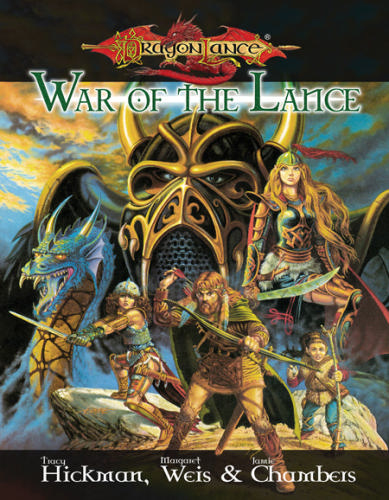Dragonlance: Towers of High Sorcery by Libertad!
Wizards of Ansalon
Original SA post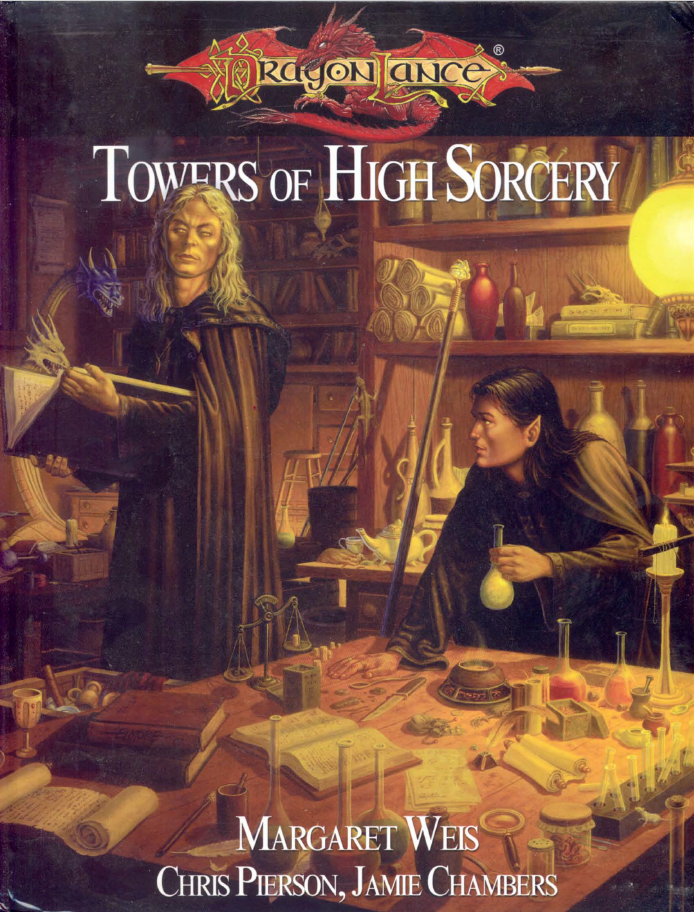
Chapter One: Wizards of Ansalon
Dragonlance was in a rather interesting position during the 3rd Edition era of gaming. Albeit an official setting, Wizards of the Coast wanted to focus on its three major worlds for publishing: Forgotten Realms, Greyhawk (albeit in bits and pieces), and the soon-to-be-released Eberron. In 2003 the company released a main campaign setting book for Dragonlance, but for further sourcebooks and material gave limited licensing rights to Sovereign Press for 5 years, which then became Margaret Weis Productions around 2007. The then-new studio had a lot of material to draw from, so they began with the most well-known aspects. During the first year, priority was placed on setting sourcebooks for the most iconic eras: the War of the Lance and Age of Mortals, the latter of which was already an unpopular setting among fans. Ironically loaned out to yet another third party studio,* it was considered the worst book of the 3e Dragonlance era.
*Fast Forward Entertainment.
But beyond the “setting” sourcebooks Sovereign Press needed ones for the other iconic features: the honorable Knights of Solamnia, the power of the gods, the time-traveling shenanigans from the Legends trilogy, and eventually a 3rd Edition conversion of the original Chronicles were all planned for and eventually published! In tackling this monumental feat, Sovereign Press started with Krynn’s color-coded wizardly orders with a book dedicated to them and all things arcane.
Towers of High Sorcery is a mixture of fluff and crunch; in addition to the oodles of new feats, prestige classes, and mechanics which were the highlight of the D20 system, the book goes into detail on the society and philosophy of the Orders and other wizardly organizations of Ansalon. It also covers those dabblers and renegade mages who choose to remain independent.
The Gift of Magic
Our book opens up with a brief discussion of arcane magic, also known as sorcery. It is the metaphysical clay which the gods used to create reality, and which mortals could use the ability at a lesser (yet no less wondrous) rate. In times long past arcane magic was a raw and barely controlled energy which mortals could directly access. It was known as Primal Sorcery, and when utilized during the distant Age of Dreams its destructive power caused the three Gods of Magic to institute more precise formulas and rituals as safety measures This form of magic is called High Sorcery to distinguish it from its older counterpart; its use is referred to as the Art, and practitioners of the Art are known as wizards. Three orders were set up to research, study, and regulate its use, associated with with their patron deity’s moral outlook on how to best harness magic. Solinari, the white moon, was the conscience of wizards and taught his followers to use their powers for the common good. Lunitari, the red moon, represented the balance and taught her followers to prioritize magical research in and of itself and is thus neutral. Nuitari, the black moon which can only be seen by the Black Robes, encourages followers to gain power irregardless of moral reservations and is thus evil. But unlike divine magic, High Sorcery’s ability to be accessed by practically anyone with the right materials and tomes meant that independent mages could learn this Art for themselves.
Creatures with natural spellcasting such as dragons still retain primal sorcery, but this power would remain locked away from the majority of races until the breaking of the Graygem of Gargath and the arrival of Chaos into the world.
The talent for wizardry is not something a person is born with; the pre-magical lives of many wizards differ widely, although they most often come from educated backgrounds where literacy is available, making their numbers relatively low in the current Ages. In times long past the Conclave, the primary governing body of the Orders of High Sorcery, sent representatives in search of people who displayed talent and/or interest in the arcane arts, with formal tests to determine their worthiness.
3rd Edition Notes: Arcane casting classes which require a spellbook or some sort of formal training are counted as High Sorcery/wizards, while those which are spontaneous casters (spells become known as you “level up” and don’t need a spellbook) are counted as Primal Sorcery/sorcerers.
Only the elven nations still maintain wizardly aptitude tests; most countries in Ansalon have varying degrees of anti-magic sentiment due to the power mages wield as well as political and religious reasons. In the Fifth Age, the Age of Mortals, some among the Orders have applied these standards to wielders of primal sorcery as well, although their existence and how best to deal with them is a hot-button issue among the Conclave.
Most arcane education in modern times takes two forms: individual master-apprentice relationships or boarding schools where teachers preside over classrooms of students. The former is by far the most common, and lessons widely differ and are often restricted to the skill set of the mentor in question. The latter is rarer due to the amount of money and resources required. Magic schools beyond Wayreth only really took off after the War of the Lance, when Raistlin’s fame in fighting the Dragonarmies began to turn public sentiment more favorably to wizards. The Orders used to have five Towers of High Sorcery which were the Ivy League equivalents of magic schools, but only the Tower of Wayreth still serves its original purpose. Arcane schools can gain funding from the Conclave but must abide by a set of universal standards: schooling lasts for 8 months from autumn to spring, dorm rooms are gender-segregated (to “avoid distractions from studies”), students under 16 years of age require a legal guardian’s permission to enroll, and class subjects are split into categories of novice/intermediate/advanced.
But there is one formality which the Conclave applies to all wizards of sufficient skill, formally-trained or no: the Test of High Sorcery. Perhaps the most iconic and feared ritual of the Orders, the Test is just as much an inward moral assessment as it is testing the competence of the wizard in question. Whether as simple as finding a letter mysteriously appearing in one’s dwelling or consciously seeking it out by one’s own hand or mentor, the prospective mage travels to the Tower of Wayreth* and meets with senior wizards to determine if they’re ready.
*The other four Towers were capable of administering Tests, but their destruction during the Kingpriest’s purges reduced the Test to the last remaining Tower.
The Test is individually customized based on the skill set and background of the test-taker, and the intention is to make the wizard aware of their strengths and follies and what path in life they wish to take in life. But every Test has two questions of vital importance: “is there anything more important to you than the gift of magic?” “And when challenged, will you sacrifice those things for the Art?”
The weight of these words is vital, for those who fail the Test are executed; even the good-aligned White Robes deemed it a lesser evil to kill unworthy students than pass powerful magic into their hands which can inflict potentially greater harm. To those wizards who pass, they are given a set of colored robes inducting them into one of the three Orders, and often bear some physical or emotional scar as a reminder of their trials. Official membership in an Order comes with many material benefits from an expanded formal social network of peers.
I can’t help but feel that the “pursue magic beyond all other affairs” is biased heavily in favor of the Red and Black robe ideologies, perhaps the Reds more than the Blacks. The Black Robes’ emphasis on selfish power precludes moral concerns, but on the other hand one can argue that said selfishness may be detrimental to magical innovation and research if say, they suppressed knowledge so as to retain a position of uncontested eldritch power. The Reds may be a bit “enlightened centrists” in regards to the Balance, but knowledge for knowledge’s sake lines up best with these questions. And while the penalty for failing the Test is made known to all prospects (and can refuse to take the Test provided they stop honing their magical skills henceforth) the use of murder can be seen as a rather large moral compromise among some gaming groups.
We then get a brief rundown on the political structure of wizards; this is expanded on in chapters three and four, but for now we get the basics. The previously-mentioned Conclave is a council of twenty-one wizards which has a governing Head who steps in when the council cannot come to a decision. Any member of the Orders can theoretically join the Conclave, but it is a lifetime membership and applicants must demonstrate sole loyalty to the Orders and magic beyond all other concerns, which typically means that they forsake prior political and national loyalties.
Furthermore, each Order of High Sorcery has a Master of its own, while each Tower of High Sorcery is presided over by a Master who is ultimately responsible for its affairs. There’s not much discussion of how one becomes an Order Master, but a Tower Master is chosen from a list of candidates assembled by the Conclave. The wizard’s skill set, as well as their community ties with the Tower’s region and the political make-up Orderwise, are all considered. Once chosen the Master becomes responsible for the Tower’s day-to-day upkeep and undergoes a ritual to merge their life force with the Tower’s essence. This grants them an unbreakable supernatural hold over the building’s foundations and the surrounding environs.
Interspersed throughout this section are some small in-character notes and letters by notable wizards from the setting, such as Raistlin and Dalamar. We even get stats for the two, although the former only as a 1st-level apprentice when he was just 16 years of age. I have no idea in what campaign you’d use this besides either time-travel or a pre-War of the Lance magic school campaign.
Races & Wizardry
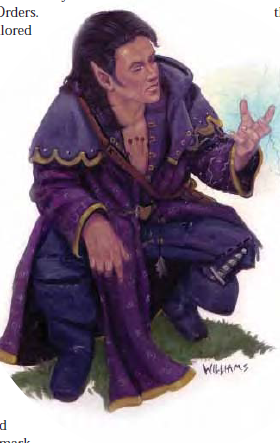
Although it can be said in general terms that sorcery is a rare and feared art in Ansalon, the various cultures and races have approached the Art differently. The fact that its use knows no racial or cultural boundaries* means that the Wizards of High Sorcery often insert themselves into every community of note during the current Age of Mortals. In some cases it may be as formal as a small keep or outpost, while others may be a single wizard or small band venturing between settlements.
*Although inherent Intelligence/Charisma modifiers can make certain groups more naturally gifted at its manipulation than others.
Humans tend to number the highest among wizards in spite of the elves being more tolerant due to human flexibility and their population spreading evenly throughout Ansalon. The city-dwelling and formal nations are more trusting of the arcane arts than rural and nomadic humans, but this isn’t much of an improvement. Even commoners give wizards a wide berth unless the individual mage in question can be trusted and has existing community ties. In Solamnia the governing Knights don’t exactly trust them but they’re not outright hated, while in Khur the populace overwhelmingly hates arcanists save for the Mikku tribe who are often regarded as the oddball group by their peers.
They’re put in their own individual categories, but the Half-X Races tend to join the Orders or take up arcane spellcasting due to being either socially isolated or caught between two cultures. As a result, they find some comfort in a community they can call their own. The exception are half-kender, who inherited a bit of their kender parentage’s side and find it hard to focus on their studies.
Elves hold arcane magic in high regard, but ones who join the Red or Black Robes become outcasts in their community. The Silvanesti have a formal House Mystic which has a joint relationship with the White Robes, while the Qualinesti capital had its own arcane school and their proximity to the Tower of Wayreth meant that they worked together on many projects. The Kagonesti wild elves are an exception in that they have no formal institutions and thus have less wizards (but not much of a social stigma against htem), while the sea elves tend to practice magic independent of the Orders. Sea elf renegades cannot be easily brought in line by the Orders on account of the difficulties of long-term undersea travel, even with magic.
The Ogre Races are an interesting case study. The initial chosen of Takhisis once presided over the first mighty civilization, but it fell due to cruelty and slave rebellions. The modern-day fallen ogres lack the intelligence or resources to study wizardry, and thus tend to treat wizards as threats. The exception are ogre magi, offspring believed to be a throwback to their first empire. Ogre magic tend to be revered for their power, and as a rule they don’t bother joining the Orders due to having their own formal network of master-apprentice relationships.
The Irda, those good-aligned ogres who weren’t cursed with ugliness for their evil ways, often live as solitary travelers posing as elves when away from their island homes. While they count a large amount of wizards among their ranks, they view themselves as being too rational and wise to need self-regulation. They treat the Orders of High Sorcery in a back-handed condescending way, viewing it primarily a “worthy institution for the lesser races” who they regard as irrational and aggressive and thus in need of a guiding hand.
Minotaurs view arcane magic as a crutch that the weaker races use to make up for physical shortcomings, and its use in battle is seen as dishonorable. As a result, the majority of minotaur wizards are those who are weaker than most of their kin and turned to alternative practices to minimize their shortcomings. The ones living among their races’ seafaring empire are renegade mages and focus on spells ideal for warfare given that such sorcery is the kind their people at least grudgingly respect. The minotaurs who leave their homeland have it even harder, in that they’re making a conscious choice to abandon their people; as a result, minotaur wizards that join the Orders are already outcasts among outcasts.
Dwarves have a long-standing cultural distrust of wizards due to the archmage Fistandantilus’ participation in the Dwarfgate Wars. After the Cataclysm fell, many old trade routes and communities were destroyed, leading to a massive food shortage in the dwarven kingdom of Thorbadin. The mountain dwarf clans barred the Neidar, or hill dwarves, from entering their ancestral homeland as the rest of the world became more dangerous.
This ‘betrayal’ caused the Neidar to ally with various human factions to break through the gates of Thorbadin, Fistantantilus among them. The archmage cast a cataclysmic spell which devastated both armies and led to a premature end of the War. Thus the hill dwarves hate wizards due to fear of being betrayed again, while the mountain dwarves remember how close Fistandantilus’ magic brought their kingdom to destruction.
An exception exists among the “dark dwarf” clans. The Theiwar clan are long-standing practitioners of wizardry in an organization known as the Obsidian Circle. The Circle pays devotion to Nuitari and have an alliance with the Black Robes even though they’re technically renegades. While the Theiwar count many primal sorcerers among the populace, the Circle regards them as threats to be destroyed. The Daegar often learn from the Theiwar, and prefer magic which can enhance their physical abilities and objects. The Zhakar, or dwarves infected with a race-wide fungal parasite, do not much care for High/Primal divides and accept whatever magic is practical for learning.
There are no recorded instances of gully dwarf wizards, not even minor dabblers, due to their races’ legendary stupidity, although there are a few primal sorcerers reported in recent years.
Gnomes are curious about magic as they are with just about anything which can be studied and researched. But they tend to regard its practice with disdain when so many spells can be replicated (either practically or in theory) by machinery. They study wizardry as a means of understanding magical cause and effect, and their cultural peculiarities means they almost always conduct such research in their city of Mount Nevermind rather than the continental schools or Towers. The gnomes have produced more than a few genuine wizards among their ranks, whose spellbooks are even larger and more baroque than usual. There are no known examples of gnomes who took the Test, not even the more powerful ones. In the latter case, such gnome archmages mostly lived uneventful lives in Mount Nevermind consumed by research rather than more earthly concerns. As a result, they more or less go unnoticed by the Orders.
Kender love magic, but the feeling among wizards is not mutual. Their whimsical nature means that formal training is a nightmare for mentors and teachers, although the Afflicted Kender (a subrace that became traumatized by the destruction of their home city) are better suited to learning but tend to be suspicious of the Orders. Some kender conspiracy theorists have claimed that there’s an Order-wide effort to prevent them from learning magic.
Centaurs overall violently hate arcane magic, and instead give credence to divine magic as practiced for generations. A few young centaurs who left their tribes to travel the world are more open-minded and thus a few joined the Orders.
Draconians are a young race who post-War of the Lance are finding their way in the world. They have been most familiar with the Black Robes, often serving them as minions. Draconians overall are more likely to be primal sorcerers, although only the auraks (who are the smartest and most magically-proficient) and the bozaks (who were trained as highly-disciplined ‘mage-warriors’) show inclination to High Sorcery in any conceivable number. There are rumors of some sivaks who used their shapechanging abilities to take the identities of murdered wizards to learn the Art, but nothing can be proven.
High Sorcery and Arcane Prestige Classes
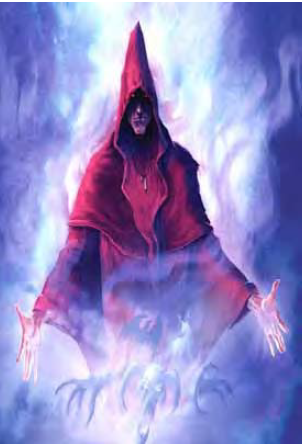
The final section of the first chapter covers new class options for the wizards of Ansalon as well as an updated reprint of the Wizard of High Sorcery prestige class from the main setting book. One thing I would like to note is that while some of these PrCs may be better than others, none of them are a real ‘downgrade’ to the core Wizard class barring the Sylvan Mage exception. This is because the Wizard’s class features are mostly spellcasting and a bonus feat every 5 levels, and magical prestige classes grant more spells per day of an existing casting class during their progression. The Wizard of High Sorcery, Dreamshaper, Sea Mage, Spell Broker, and Winternon are all full progression, while the Griffon Wizard and Renegade Hunter grant +1 level of progression every odd-numbered level and are only 5 levels long, meaning you only lose out 2 levels at most. The Dark Dwarf Savant’s the odd man out, a level 10 class with a total of +7 levels in an existing casting class, and the Sylvan Mage is a 10 level class which grants casting progression every odd-numbered level.
Wizard of High Sorcery is a Prestige Class symbolizing those who completed the Test and formally joined one of the three Orders. I covered it in a prior review of the Dragonlance Campaign Setting, but the major change here is that you no longer have to specialize in a school to qualify. Non-specialist wizards have to choose a specialty school favored by their order and are thus treated as one from then on out, but those who were already specialists gain even greater power (+1 caster level and saving throw DC on related spells) at the expense of choosing an additional prohibited school. Overall it’s a pretty solid choice for specialist wizards, and some of the Order Secrets are pretty good.
Dark Dwarf Savants are worshipers of Nuitari and established ties with her aforementioned Order during the Age of Mortals. They count sorcerers among their ranks as well and tend to plot various evil schemes in the mountain kingdom of Thorbadin. Their primary class features include the manifestations of magical mutations which grant +2 to an ability score of choice per selection but become more resistant to healing spells; the ability to permanently sacrifice up to 3 spell slots to prepare a spell as a spell-like ability (which allows them to avoid gold/steel piece cost but must spend the virtual currency as more expensive experience points); and bonus item creation feats.
The Savant loses 3 levels worth of casting class progression, but the ability to turn certain spells into spell-like abilities has some pretty powerful potential.
Dreamshapers are illusionists of Lunitari who study dreams and the Ethereal Plane to gain increased power over mortal perceptions. They were instrumental in rebuilding Silvanesti after the War of the Lance, when nightmare-spawned horrors were still numerous. They can coordinate efforts among their number to power all of their spells, using the mechanics of Faerun’s Red Wizards from the Dungeon Master’s Guide as part of a wider “dream circle.” Their other class features include saving throw bonuses against illusion and mind-affecting spells equal to their class level, and a +1 to +3 bonus on illusion (phantasm) spells depending on their class level. They have some steep prerequisites in terms of minimum level (you’ll be 10th when you gain your first PrC level) but overall they’re a pretty solid choice for illusionists, moreso if you have a Leadership cohort who also takes levels in it to take advantage of the circle magic.
Griffon Wizards are elven warriors who gain a powerful bond with the eponymous flying beasts. They are most common among the aristocracy and martial orders of the Silvanesti and Qualinesti, and are exclusively White Robe wizards of Solinari. They gain a griffon as a unique familiar (and cannot have an existing one), but is more in line offensively as a paladin mount. They gain bonuses on concentration checks to maintain spells while riding their mount (which ranges from +5 to +10), and can gain temporary bonuses to their Strength and Fortitude saving throws (or Charisma and Reflex) as they draw on the power of their mount’s bond.
Their level 5 capstone feature lets them auto-succeed on all concentration checks while riding their mount. To non-D20 readers, a concentration check is rolled whenever a spellcaster takes damage or is in environmental conditions which can distract their spellcasting. Concentration DCs can climb really high with damage, and what this means is that a Griffon Wizard can pretty much cast spells without worry. With the aid of a flying mount, this is another solid class and only 5 levels to boot.
Renegade Hunters are wizards charged with keeping the power of the Art out of the hands of the unworthy. Sometimes it may involve teaching a renegade the boons of formal membership in the Orders, while other times it is a more violent choice resulting in the arrest or death of the renegade. Its prerequisites are a bit unorthodox, with skills and feats themed around investigative measures (Gather Information, Sense Motive, the Track feat, etc). Their class features revolve around the countering and shutting down of enemy magic and include things such as: treating their patron moon as being in a more favorable alignment 1/day*; automatically learn the Detect Lie spell and Mark of Justice spells at 2nd and 4th levels; can afflict an enemy wizard as though they had a patron moon being in Waning/Low Sanction*; and their 5th level capstone ability can let them temporarily reduce their own caster level and cause a target within 30 feet to suffer an equally reduced caster level 1/day for a limited number of rounds. Caster Levels lost this way can dip to as low as 0, which can eliminate the ability to cast spells at all!
*Order wizards’ DCs and Caster Levels can suffer bonuses and penalties depending on their phases.
The Renegade Hunter has some pretty potent anti-magic countermeasures, but they can only work on wizards and not arcane spellcasters in general, which drastically limits its use in most campaigns.
Sea Mage is a wizard who spent a lot of time at sea and learned to shape their magic in favor of their lifestyle. They are more physically inclined and less formal than most wizards, being closer to a sailor than a scholar in temperament. They are a full casting class up to 5 levels, but require a high base Reflex Save (+3) which means they need to multi-class to gain early entry. But in exchange they gain bonuses to skills related to seamanship; bonuses on Concentration and save DC when onboard a ship or in an aquatic environment; bonus feats related to agility and metamagic; and can affect an entire sea-going vessel with a single spell a limited number of times per day and can gain said spell’s benefits while in contact with the ship; and +1 caster level in regards to air and water based spells.
Dragonlance isn’t exactly known for nautical adventures, but I can definitely see this Prestige Class being used in Freeport or a more pirate-themed setting. The “target an entire ship with a spell” is open to some abuse, but its limited use per day keeps it in line.
Spell Brokers are the closest thing the Dragonlance setting has to “magical item shops.” They are wizards who utilize connections among merchant networks and communities to supply spellcasters with components and minor magical items, but mechanics-wise they are more akin to craftsmen. Spell Broker is a short 5 level full casting class and whose abilities are geared entirely towards item creation: they gain a bonus item creation feat every odd-numbered level, and can choose one among said feats to craft said items with a 10% reduction in gold and experience cost. They can transfer this feature every time they gain a new item creation feat, so they don’t have to be saddled with the mere scribing of scrolls when they learn how to create RINGS OF POWAH. Their other major feature is creating Items of Distinction and Renown at 2nd and 4th levels: they can reduce such costs by another 10% each and grant +1/+2 effective caster levels on the magic within said items for level-dependent variables and save DCs.
Another powerful class, which can be combined nicely with Eberron’s Artificer. Your party members will love you for this.
Sylvan Mages are those few wizards who came into contact with faeries and learned of their secrets. They are a level 10 PrC who only gains 1 effective spellcasting level every even level, the lowest of the classes here. This is a pretty big downgrade, so do the class features make up for it?
Well, not really. They gain some druidic class features such as wild empathy and the ability to cross unimpeded through natural foliage among other things, but what they get that druids do not are new Sylvan Rites every odd-numbered level. They permanently sacrifice a spell slot to learn a rite, and gain its use by meditating for 10 minutes in a natural setting. The Rites tend to be either 24 hour buffs to an ability score or the granting of a spell-like ability such as Speak with Animals, or a 3/day spell-like ability such as Sleep, Greater Invisibility, or Tree Stride. All in all, none of these features wow me or are something that seems worth the trade-off for more potential arcane spells already on the wizard’s spell list, and the spell-like abilities aren’t the kind which really benefit from being cast that way.
The Winternorn is our final Prestige Class, representing a tradition among the Ice Folk of Ansalon’s far south who learned to see into the River of Time. They specialize in divination and cold-based spells and are a full-casting 10 level class. Their class features include Cold Resistance which reduces damage from cold-based attacks and increases with level; can choose to change the energy damage of any spell they can cast to cold and grant the cold element subtype to summoned creatures*; and a limited number of times per day can see into their own or someone else’s wyrd and gain a +10 bonus on an Initiative, Knowledge, or Sense Motive check; and as their level 10 capstone ability gain the cold subtype which grants them immunity to cold-based damage but vulnerability to fire-based environments and elements.
*We get a new Cold Element subtype, which doesn’t really do much to a creature besides grant them bonus cold-damage on natural weapons, darkvision, damage reduction/magic, and the ability to treat icy terrain as normal terrain.
I really like the winternon, both in mechanics and thematics. The Wyrd ability is quite useful and can ensure that they go first (or close to first) in a fight when it matters.
Thoughts So Far: This chapter has a strong start. It has a good general overview of the history of arcane magic, what makes it different in the Dragonlance setting from divine magic, and examines how the various peoples of Ansalon view it. Its Prestige Classes are overall flavorful and have useful features.
Join us next time as we cover new spells and magic items in Chapter Two!
Spells & Magical Objects
Original SA post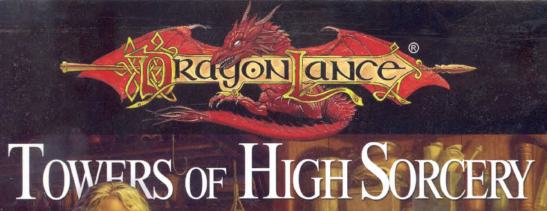
Chapter Two: Spells & Magical Objects
Prior Chapter Notice: A reader pointed out that the minotaur's view of magic in battle as both "dishonorable" and "grudging respect" seems to contradict itself. While many IRL cultures have hypocritical traditions and wouldn't be out of place in fantasy worlds, the text itself doesn't really elaborate on this so it may be poor editing at play.
This part of the book is the other big “player-facing” side of Towers of High Sorcery. We have 31 new spells, 22 magic items able to be crafted by characters, and 11 artifacts. All of these entries include some options which have appeared in prior Dragonlance material but got updated to 3rd Edition.
We also get a magical lexicon and glossary of common concepts for words in Magius, the written form of arcane magic:
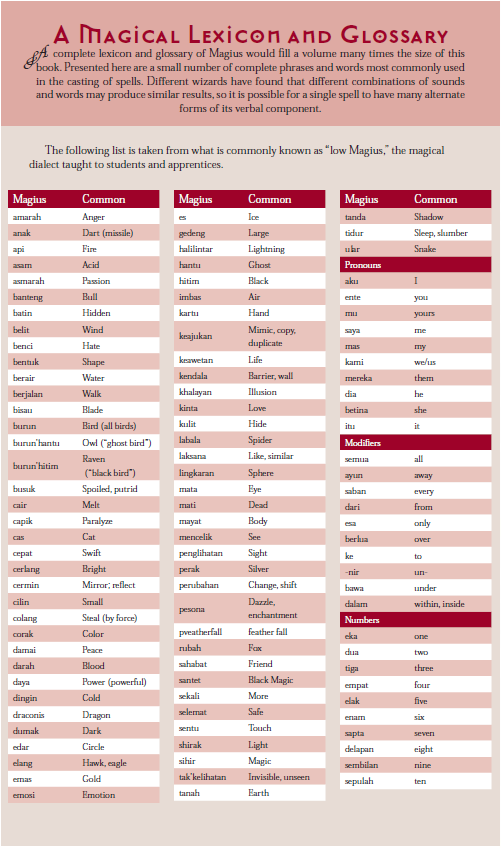
Spells
Each of these spells without exception can only be learned by sorcerers or wizards, and six of them are wizard-only. A few of the spells are related by subject manner, so I’m grouping them first, leaving the miscellaneous spells after them in alphabetical order.
Emulating the Divine: Wizards have long been jealous of the magic of the gods and sought various means of replicating their effects. In some cases they’ve been successful, but the end result often falls short of the real deal. Awaken the Mind is a limited-duration equivalent to the Druidic Awaken spell, granting sapience to a creature of the animal type. Life Transfer is one of the few spells which closely emulates divine healing. However, it drains hit points from a touched target and grants the damage as temporary hit points to the caster edit: but the caster can either heal half that temporary hit points as real hit points or transfer the energy into another touched creature one round later and they heal real damage up to the temporary hit point total. Reverse Death functions as raise dead but has a shorter window of time in which a person can be brought back to life, does not purify their body of poison or disease, is 9th-level, and the target must make a Will save upon revival or else die again. Shape of the Beasts enables the caster to transform themselves or a touched humanoid into an animal a la wildshape, but risk devolving to animal intelligence and instincts the longer they remain in that form. Truth-Testing is like Discern Lies but lower-level and single-target.
Inception: D&D Edition: These spells involve screwing around with a target’s memory or conjuring some mental dreamscape. Displace Memory removes 10 minutes per caster level of an unbroken sequence of memory from a target and implant it into the caster’s mind, and remains crystal clear within said mind for 1 day per caster level. Mindspin has a long casting time and hefty gp and xp requirements, but can plunge a target into an illusory nightmare world where they fight dreamshadows* and dreamwraiths* you can summon. Further failed saves grant various buffs to said monsters as they slip deeper into the nightmare. This spell has a Greater version which can work on one creature per caster level instead of a single target. Travel the Paths of the Mind is a rather involved spell which allows the caster and some other targets to travel into an individual’s memories, and can even pull out objects to take back into the real world. Albeit this last part comes with contested Will saves and the dangers and traps within the mindscape can be very real to travelers.
*monsters detailed in Chapter Six.
Spells of Timey Wimey Stuff: Reprinted later in Legends of the Twins, these spells involve manipulating the flow of the River of Time. Timeheal rewinds time so that the target’s wounds and ailments fade away (albeit with a 1 minute casting time, gp and xp costs, and a subject can only be affected 1/day by it) while Time Reaver is known only by the Masters of the Towers of High Sorcery but can theoretically be learned by a sorcerer. It opens up a portal which sends travelers 20 years backward or 1 year forward in time per Caster Level. But it comes with a hefty cost of money, experience, and the temporary depowering of a major artifact as an arcane focus.
Wizards Only: These spells can only be learned by Wizards, not Sorcerers, and are closely tied with the Conclave and/or Orders. Consensus is a 9th-level spell which is typically taught and cast by the highest-ranking Wizards of High Sorcery. It reserved for the purposes of voting on matters or in times of create crisis like the Kingpriest’s purges. It has an unlimited range where it can send a message up to 10 seconds long to all members of one particular Order, or members of all Orders. It is silent telepathy which can automatically overcome all mortal mental defenses, and those who receive it can return a one-word reply. The most popular response is filtered to the caster as a single answer.
There are five 7th-level spells keyed to particular Towers of High Sorcery. When cast upon a target they allow them to circumnavigate the Towers’ external defensive measures. Kiss of Night’s Guardian allows someone to be unaffected by Palanthas Tower’s aura of fear, while Touch of Guiding Light for the Tower of Wayreth allows one to find their way through the magical forest surrounding the Tower and an intuitive sense of its location. The three spells for the destroyed Towers (Song of Day’s Clarity, Vision of Dusk’s Eye, Whisper of Dawn’s Song) have been lost in modern Ages and will not be useful save in time-travel or pre-Cataclysm campaigns.
Arcane Eye, Greater is a 7th-level version of its 4th-level counterpart but grants you darkvision, low-light vision, and the true seeing spell which can penetrate illusions and ethereal/invisible things.
Arcane Staff allows you to infuse a nonmagical quarterstaff with spells up to a combined total of levels equaling your Caster Level. They remain within the staff until discharged, which is a useful way of gaining bonus spells per day if you’re settling down to rest for 8 hours or completed your current dungeon crawl/adventuring day. It also comes in Greater and Lesser variants which affect the max spell level of individual spells which can be stored.
Cleaning is a cantrip which does the clean function of Prestidigitation but affects a 5 foot cube instead of a 1 foot cube per casting. Superfluous.
Curse the Magi puts a debilitating curse on another arcane spellcaster. If they fail a Will save, every time they cast a spell they must roll another Will save or have said spell fail and suffer Constitution drain. It’s touch range but very debilitating.
Detect Familiar is exactly what it sounds like and is about as useful as you can imagine.
Disarm not only forces a target to drop a held weapon, they must roll a Will save every other time they attempt to grab a weapon during the spell’s duration.
Feign Life allows a corpse or undead creature to appear to have surface-level mundane indications of life (internal body temperature, beating heart, etc). It does not get rid of weaknesses of their type.
Giant’s Guise makes you appear one size category larger and grants +8 Intimidate to those who do not successfully disbelieve the illusion. Very useful for demoralize-centric builds.
Raistlin’s Wheel of Flame costs 250 gp worth of material components to cast making it quite the hefty price tag for a blasty damage spell. It’s a 60 foot radius burst which lasts for 1 round per caster level, dealing 1d6 fire damage on the first round, 2d6 on the second round, and so on and so forth to a maximum of 15d6. It’s stationary and takes a while to start dealing appreciable damage, which limits its usability in combat barring preparation, ambushes, and the means of forcing an opponent to stay within the AoE.
Stone Guardian summons one Medium earth elemental to serve the caster. It is basically akin to Summon Nature’s Ally IV which can accomplish the same thing, but is limited to that specific creature type, is 3rd-level rather than 4th, and Conjuration (Creation) rather than (Summoning) given that it is made from a clay figurine material component. This last part is rather important to highlight given that said elemental will not gain the boons of summoning-related buffs, which dampens the usefulness of said spell.
Suppress Magic temporarily suppresses the effects and usability of all magical items in a 10 foot radius and lasts for 1 round per level. This is a rather powerdebuff, although the radius is not implied to move from its location meaning that stricken opponents may escape with a single move action unless otherwise bound.
Transfer Essence causes a spellcasting target to suffer temporary negative levels, while the caster of the spell gains temporary level increases when determining the effects of their spells’ duration, damage die, overcoming Spell Resistance, and so on. The text notes that it’s common for more powerful spellcasters to have willing servants be afflicted with this spell so as to further power their master.
Magical Items
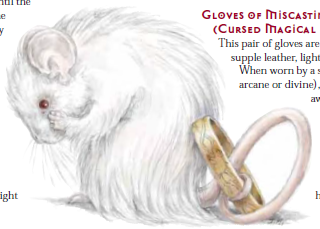
Given the high number of magical items in this section, I’m going to focus on the more interesting ones when possible.
Bracelet of Foresight can warn of danger 1/day and grant a sudden vision a la the Foresight spell for 10 minutes, and a constant +2 bonus on AC and Reflex saves.
Bracelets of Magic Resistance were made by the Black Robe Wizards because they’re the most likely to get into fights with other mages. The bracelet can absorb up to 25 levels worth of magic directed at the wearer before crumbling to dust, but are EVIL and bestow negative levels on lawful good wearers (but not neutral or chaotic good ones, oddly enough).
Cloak of Night gives you Darkvision, +2 to AC, +10 to Hide when shadows are present, and can cast Shadow Walk 1/day allowing you to teleport between shadows.
Golden Rings of Healing are prized possessions by wizards for they require the Timeheal spell to craft. They can heal the wearer up to 6 points of damage 1/day, and can bring a user up to 1 hit point if hit by an attack which would render them dying or dead. The ring’s magic forever ceases to work if this last event comes into play, however.
Gully Dwarf’s Emerald works only when the wearer is a naturally Small creature and is offered as a bribe to someone. Once this happens, the target’s filled with an overwhelming urge to claim it. When they touch the gem they suffer 3d6 Constitution damage and are paralyzed. The gem teleports after this into the hands of another potential user, and given said spell’s range makes this a gimmicky yet powerful one-off item at best.
Message Bottle is basically a magical tape recorder. It allows a speaker to communicate a message up to 10 words into the bottle and ‘trap’ the message inside with a rune-engraved cork. The next person to open the bottle then hears the message. The text specifically points out that it cannot be the verbal component of a spell. But it says nothing about words so loud that they deal sonic damage, but I presume the intent of the rules doesn’t allow for this either.
Ring of Projection can create a visual illusory double of the wearer up to 60 feet away.
A Ring/Robes/Staff of High Sorcery is keyed to one of the three Orders and bestows negative levels on a wear of incompatible alignment. Rings grants several minor boons to Order members only, such as at-will Detect/Read Magic, a free Enlarge Spell metamagic effect 1/day, and +2 on caster level checks to overcome spell resistance. Robes have similar prerequisites, but have more powerful boons: they grant sizable bonuses to saving throws, armor class, Spell Resistance, and +1 caster level on spells related to the Robe’s particular Order. A Staff can cast various spells by expending charges, with a set of universal powers and some additional spells based upon its relevant Order (illusion spells for Red, necromancy for Black, abjuration for White).
Scroll of Stellar Path causes a rift in time, causing one of the three moons to assume High Sanction (Waxing/Waning Gibbous and Full) in the sky and grant the benefits of +1 Caster Level and Spell DCs to the relevant Order wizards for 48 hours.
The Thieves’ Bane Pouch, is also known as a Kender’s Bane Pouch, is a command-operated Bag of Holding. Anyone who reaches into the bag without the proper command word is surrounded by a paralyzing force field on a failed Reflex save.
Artifacts
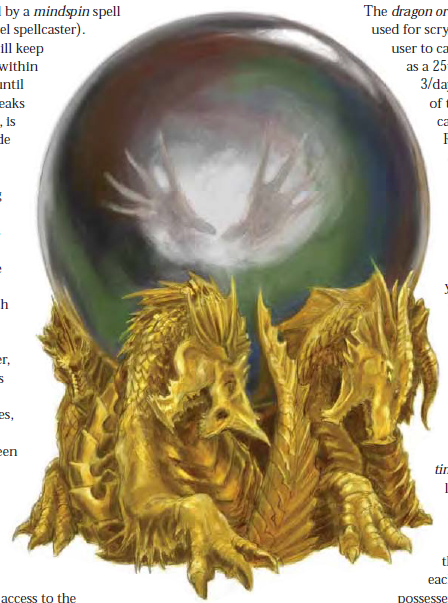
Most artifacts in Dragonlance were created by the gods during the Age of Starbirth, or by powerful spellcasters during the Age of Dreams and whose effects cannot be replicated today. In modern Ages no known artifacts have been created save for whatever Raistlin Majere might have worked on in his magical research.* The ones in this book have a relationship with the Orders of High Sorcery and hold significant historical value to wizards.
*yes the book calls him out by name.
Artifacts of the Moon Gods: Bracers of Solinari were believed to be crafted by the good God of Magic himself. They grant the wearer a bevy of constant defensive benefits (AC bonus, Spell Resistance against other spellcasters based upon their tradition/class) as well as the ability to cast Spectral Hands 3/day (make touch spells at range) and Dispel Magic 1/day. Also the wearer can cast a spell as if Solinari was in High Sanction 1/day. If said moon is already in High Sanction then it works as though it were in conjunction with another moon at High Sanction, or treated as the Night of the Eye (all 3 full moons) if two moons are already gibbous/full.
Nuitari’s Shroud is the more sinister counterpart to the Bracers of Solinari. It can only be worn safely by Black Robe Wizards and has similar features to the bracers (defensive abilities, treat their patron moon as High Sanction, etc). The major difference is that it casts Gaseous Form 3/day and Shadow Walk 1/day.
Finally, Shield of Lunitari is the neutral artifact of the trio and is treated as a +5 buckler with no arcane spell failure chance or armor check penalty. It casts Spell Reflection and Wall of Force as its 3/day and 1/day abilities along with the universal defensive and moon god artifact defaults. I find the shield’s spells odd, as they seem defensive and more in line with Solinari. I would’ve expected illusions to throw off the wielder’s position in combat, or a spell which transforms weapons which strike the shield.
Tomes of the Moon Gods: The three respective Tomes of Solinari/Lunitari/Nuitari all have the same benefits but whose abilities are keyed off of the reader’s alignment. Wizards of the appropriate alignment who read the tome gain a +1 permanent bonus to Intelligence and one experience level. Wizards of inappropriate alignments who read the tome lose experience points and must receive an Atonement spell to gain any further experience points from then on out. Noncasters are unaffected if they read the tomes, while divine casters of all kinds take 1 point of permanent Wisdom drain and suffer experience point loss (but no Atonement required). Once read by a wizard, the book vanishes from their sight.
The Dragon Orbs are Krynn’s equivalent to the Orbs of Dragonkind: they are capable of mentally controlling dragons as their most notable ability, and were created by the Orders to fight Takhisis’ chromatic dragons during the Third Dragon War. Each orb has the spirit of a chromatic dragon within, who will attempt to tempt and eventually possess the wielder. But users who can overcome the battle of wills can tap into the Orb’s power, which among other things can mentally summon dragons to the user’s location, mentally dominate them, and enact a mile-wide confusion-afflicting attack against all dragons and creatures with the Dragon type.* Finally the orbs can let the user scry into the past or future.
*In the Dragonlance Chronicles this feature of the Dragon Orb can be used during the Battle of the High Clerist’s Tower to more or less destroy the Dragonarmies’ draconian troops, while the dragon-summoning can be used to trick the blue dragons into entering inescapable hallway portcullis traps.
Encyclopedia of Magical Devices is not truly magical, but is an exhaustive list of every known magical artifact made during the Age of Starbirth and Dreams, aka virtually every artifact which exists in the setting. It also details proper rituals necessary to create non-artifact magical items which have since become “common” to the Orders. It is currently in possession by the Master of the Tower of Wayreth and guarded under innumerable abjuration spells and glyphs.
Gauntlets of Ventyr were created by the dwarves of Thorbadin to help fight against wizards. It automatically absorbs arcane spells cast within 10 feet of the wearer and stores them as charges, and an arcane spellcaster who wears said gauntlets can spend the charges to increase their caster level or reduce the effective level increase of metamagic feats. It’s also inhabited by a wizard ghost who can telepathically communicate with the wearer and has full stats to boot!
Mantooth is a longsword notable for being wielded by Caramon Majere, one of the Heroes of the Lance. It is a longsword with the Bane quality against arcane spellcasters, creatures with spell-like abilities, and magical beasts (+2d6 damage against them) which are a fair portion of published monsters. It can also parry spells back at the wielder via spending an attack of opportunity and making an attack roll against a DC of 10 + spell level + spellcaster’s relevant mental ability score modifier. It also can dispel a magical barrier with a percentage chance equal to the damage dealt. Overall this is a pretty great magical weapon with many uses!
Portal to the Abyss is a corrupted artifact, originally a teleportation gateway network made to allow for instantaneous travel between the five Towers. A failed experiment opened them into the Abyss instead, which would have allowed for Takhisis the opportunity to slip into the Material Plane were it not for some speedy work in sealing the portals by the wizards. The five portals were destroyed or went missing after the Cataclysm, but if one were to be found, it can only be opened by the efforts of a Black Robe Wizard and Cleric of a good-aligned deity (ostensibly the latter would be forced and unwilling). Both must participate in a ritual, the Cleric as the channel and the Wizard as the caster for the spell. Failing the ritual causings a mile-wide magical explosion and earthquake which destroys all living creatures in its radius. If successful, it opens up a two-way portal into the Abyss, and the wizard can control the opening and closing of all five Portals without the cleric’s aid provided he can find their respective location in the Abyss.
Interestingly, a portal much like this one played a prominent role in said goddess’ plans during the Dragonlance Chronicles. The goddess transported the Temple of Istar from the Blood Sea into the mountainous region of Neraka, and from here Emperor Ariakas and the Dragonarmies based their capital out of during the War of the Lance. However, it was different than the portals here on account of needing a Foundation Stone to function. The Abyss Portal which was initially in Istar’s Tower of High Sorcery was relocated during the Kingpriests’ purges far away from the capital city, so it cannot be that one either.
Thoughts So Far: I like the assortment of spells and magic items. Many of them provide useful features, although I have a bit of mixed feelings in regards to the “divine spellcasting copycat” ones. While they fit thematically in that I can totally see wizards experimenting with ways to mimic other traditions, their clear inferiority to their divine counterparts make them poor options for selection unless you’re playing during the era between the Cataclysm and War of the Lance when divine magic was stricken from the world.* The artifacts are pretty cool, although I felt that the moon god artifacts/tomes were a bit too samey and came off as attempts to expand the chapter’s word count.
*But then I’d ask why you’d be using D&D for this, as such a low magic setting can’t really be replicated well in the D20 System. I’ve heard good things about Spheres of Might allowing for low-magic campaigns, but I do not know if even that sourcebook can make up for the no-divine rule.
Join us next time as we cover more in-depth political workings of the Orders and their relationship with the gods in Chapter 3: Gods & the Orders!
Gods & the Orders
Original SA post
Chapter Three: Gods & the Orders
This chapter’s a bit poorly titled; it implies that it covers the relationship between the deities of Dragonlance and the Orders. While this part is true, it’s more like The Gods, and also the Orders in terms of subject matter in that we cover subjects of a secular nature as well: the history of arcane magic in Ansalon and Conclave politics.
The Gods of Magic & Role of the Other Gods in Magic
I’m combining these two sections into one due to related material. We first cover the three gods of magic. Solinari, Lunitari, and Nuitari are also the same names for the three moons in the sky and have an intrinsic connection, although more in a sense of “Apollo is the god of the sun” rather than “Apollo is the sun.” They have less of a hostile status between each other than the traditional good/neutral/evil divide of their divine peers; more of a rivalry than a blood feud. Individual members of the Orders do come into conflict, but the Orders and their patrons’ uniting cause is the promotion and regulation of magic. When primal sorcery ran wild in the Age of Dreams, the Orders figured that pooling their resources for these overarching goals but otherwise remaining autonomous was an ideal compromise. But the return of primal sorcery in the Age of Mortals is straining the Orders’ once-strong bonds on how to handle the increasing number of spontaneous magic users.

Solinari’s Ideology promotes the use of magic for the public good along with caring for those unable to help themselves. During the rise of the Kingpriest it appears that anti-arcane sentiment was not limited to just Istar’s government, for Solinari was trying to convince the other Gods of Good that they should not fear those who practiced it and was one of the few among their number to view the rise of the Kingpriest as a bad thing.
Wait, hold on a second here. The Kingpriest’s anti-magic purges were something the good-aligned deities agreed with, and not one of the reasons for why they brought about the Cataclysm?! Was their breaking point the anti-kender laws or the mind-reading secret police or something?
In spite of his “magic for all” ideology, Solinari’s limits are reached when it comes to primal sorcery, viewing magic which cannot be regulated by the Orders as a force that can destroy the world. But he views Nuitari’s advocation of Sorcerer genocide as going too far. As a result, the White Robes heavily encourage sorcerers to join the Orders as equals. Supposedly that is; Solinari is getting along with his evil brother due to a shared distrust of sorcerers.
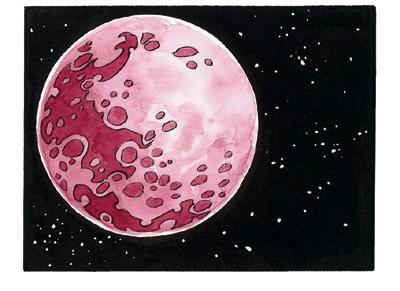
Lunitari’s Ideology is more -freespirited than her two brothers and views all forms of rules and regulations with suspicion, which makes me wonder why she agreed to the creation of the Orders in the first place. She and the Red Robes view magic as a means of self-empowerment, and that its study should be encouraged in all its forms as a means of furthering this. She and the Red Robes are also the most tolerant of sorcerers, and Lunitari has been known on a few rare occasions to manifest in front of a primal magic user just to ask them questions and develop research rather than for the purposes of conversion. She takes a hands-off approach and even encourages sorcerers and wizards to cooperate, but if primal magic users ever made their own equivalent Orders then she is in agreement with Nuitari that they should be crushed.
So much for the Tolerant Middle.
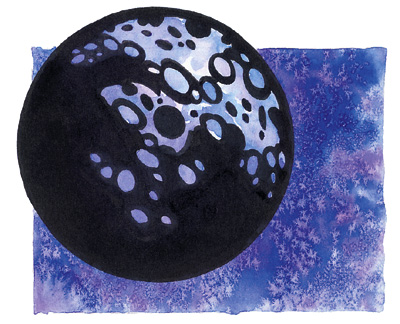
Nuitari’s Ideology encourages magic as self-empowerment like Lunitari, but also to use that power to dominate others. They obey the bureaucracy of the Orders and Conclave in a “strength in numbers” way given the many centuries of anti-magic sentiment which threatens them all. Nuitari is on particularly poor terms with the divine evil gods on account that Takhisis has a track record of stealing magical power for herself; both in the creation of her own order of the Gray Robes and with the theft of the world during the Chaos War. But he’s encouraged the spread of arcane magic among the minotaur race in spite of their cultural distrust, viewing them as the next rising superpower on Krynn.
Nuitari has found new reasons to bond with his good-aligned sibling due to sharing a distrust of primal sorcery; like Solinari he believes that they may destroy the world if left unchecked, but he encourages his Black Robes to murder sorcerers where they can rather than attempt to recruit them. Lunitari just looks at her brothers and goes “you both are crazy.”
So how do the Other Gods view and approach arcane magic? Well they mostly take a hands-off approach, using their own divine magic to control and regulate their followers. This was different during the rise of Istar during the Age of Might, where the good-aligned gods minus Solinari gave the Kingpriest their blessings to limit the power and influence of the Orders due to a belief in the “absolute power corrupts absolutely” when it came to arcane magic. Even up to and including state-sanctioned violence.
The gods of magic were quite rightfully pissed off at the Gods of Light for being hypocritical bastards, but their protests fell on deaf ears. The Black Robes and a sizeable amount of Red Robes suggested an eye for an eye to show the Kingpriest that they’re not to be trifled with, although the White Robes realized that they will not win against Istar long-term and sought a possible compromise/ceasefire. A ceasefire which in the next chapter we find out was sabotaged by a Black Robe assassination attempt (see Istar: the Bloody-Fingered Hand entry).
Eventually the rest of the pantheon realized that granting legitimacy to the Kingpriest’s government was a terrible idea, and eventually set in the biblical signs which led to the Cataclysm. The gods withdrew from the world afterwards, save the three Gods of Magic who really had nothing to atone for when it came to Istar’s rise. After the rest of the pantheon returned to the world during the War of the Lance they adopted a more respectful yet arm’s-length attitude towards the Orders, not eager to repeat the mistakes of the past.
There’s no mention of how the Neutral pantheon felt about Istar’s policies. The evil gods were no doubt opposed, although in the sense that they were the ones whose worshipers were suffering the most at the Kingpriest’s hands.
Takhisis is the major exception to the arcane-divine divide. Nuitari being her son, she initially thought he’d be loyal to her upon his birth and resented the fact that he kept the powers of the Black Robes under his exclusive thumb all these millennia. She decided that she would create her own order of wizards shortly before the Fifth Age. Takhisis’ Gray Robes were a new subsection of her new knightly order, using a cosmic magical loophole to grant them arcane magic directly while also subtly recruiting from the Black Robes. The Gods of Magic, Nuitari in particular, were angry at the usurpation of their power, but their demands for punishing Takhisis were put on hold when Chaos broke out of the Graygem and all hell broke loose. She took the world and hid it from the other gods in the confusion, and for a time was Krynn’s only true deity. But a lot of stuff happened in the War of Souls novels: she died, Paladine became mortal, and now the Gray Robes and the Knights of Takhisis (now the Knights of Neraka) are a godless, secular order yet still potent in the magical arts.
So long story short, the Gods of Good and the Gods of Magic are power-hungry hypocrites who talk a big game about ideals but throw that all out when a possible threat to their status quo arises.
History of High Sorcery
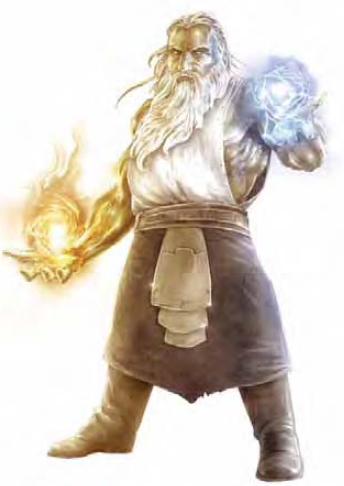
Age of Starbirth: The mortal races did not exist yet, and the gods were fashioning the very fabric of the void into reality. The sparks from Reorx’s forge created the stars which contained spirits. The gods warred over these potential new spirits and what to do with them, and as a compromise the spirits were fashioned into mortal bodies (good gods) with free will (neutral) but would sicken, age, and die (evil so that they can be tempted). The three moons were placed into the heavens so that the Gods of Magic would look down upon the world. The Graygem held a bit of Chaos, the primordial entity which existed before time and space had meaning, and was secreted away within Lunitari’s moon in an attempt to calm the raging entity.
Age of Dreams: the only known magic was divine magic, and the elves and ogres received many blessings. The humans, children of the neutral gods, were exploited by the others because the neutral gods withheld their magic for unknown reasons. The gnomes built a spaceship to Lunitari and ended up taking the Graygem down to Krynn to harness as a power source but ended up breaking it. The primordial energy spawned and twisted life all over Krynn, giving birth to new races as well as primal sorcery which until now only dragons could manipulate. The gnomes tried to hunt down the now-mobile Graygem which wreaked havoc all over the place, but the few hunters were warped into the first non-dragon primal magic users and became the Scions. Spontaneous displays of sorcery began to spring up among the other races.
The elves got tired of humans and ogres and colonized a forest filled with dragons. Neither side was eager to live alongside each other and they ended up in a war. The three Gods of Magic shown dreams to the elves of how to create five magic runestones* to end the First Dragon War, absorbing the dragons’ spirits into the stones and burying them deep within the mountains.
*If you think these sound like the Dragon Orbs, they’re not. These won’t be invented until the Third Dragon War.
The dwarves dug too deep and rediscovered the runes, letting out the spirits which returned to the dragons’ bodies. The dragons declared war against the elves again with the aid of ogres and lizardfolk, with both sides making use of sorcery in the Second Dragon War. The all-out arcane warfare rent such massive devastation to the land that the Gods of Magic gathered up the three greatest sorcerers in a citadel and cast them into the Beyond. Vowing to never let such a catastrophe happen again, the Gods of Magic worked with the sorcerers in the citadel in finding ways of reshaping Primal Sorcery into safer conduits. And here the seeds of the Orders of High Sorcery were planted, philosophical ideals and scholarly workings penned down for future generations known as the Foundations of Magic. They spread their findings among trusted members of the mortal races and constructed the Towers of High Sorcery, working together to learn and control arcane magic.
The Third Dragon War came when Takhisis decided to lead the chromatic dragon clans in conquering Ansalon. This was an age of myths and legends, when a brash upstart Red Robe named Magius and a promising young knight named Huma went on an epic fantasy RPG journey to defeat Takhisis with the aid of the newly-forged Dragonlances. The Orders were not slacking off during this time, and the entire Conclave participated in a ritual to create the Dragon Orbs based off of elven magic blueprints. Each Tower thus had its own orb to safeguard after the war ended.
Age of Might: Takhisis was slain by Huma and Krynn was at peace. The empires of the elves, Solamnia, and Ergoth were fading in comparison to the rise of Istar, which would soon grow to be the American Evangelical Christian version of Lawful Good: preaching a lot about holiness but acting like hypocritical Lawful Evil jerks. The Kingpriests were so obsessed with wiping evil from the world that they enforced more and more oppressive laws: making even neutral-aligned faiths illegal, enslaving and genociding entire races which had “fallen from the Light,” declaring kender inherently evil and offering bounties for their deaths and capture, and the belief that the Orders’ vaunted self-regulation wasn’t enough when arcane magic could be potentially learned by anybody without the aid of a god.
With the blessings of the Gods of Light and the unknown sabotaging of the Towers’ various groves, Istar’s armies besieged the Towers. During this time wizards were hunted down and murdered all over the Empire. The Orders’ headquarters were forced back to the Tower of Wayreth at the southwest end of the continent, the only Tower which remained standing. It turned out that a crafty Black Robe archwizard named Fistandantilus revealed to the Kingpriest that he helped sabotage the Tower groves so that he’d be the greatest remaining mage on Krynn, and that he should be appointed as a governmental advisor due to the great boon he granted to the unwitting Kingpriest. Despite being very, very obviously Evil, the Kingpriest agreed…but only because he wanted to keep and eye on him and not because this is an obvious political power grab! The Kingpriest is still Lawful Good, guys, Paladine still granted him spellcasting ability up to the time when-
Fuck it, there’s really no justification for this. The Gods of Light are hypocritical bastards.
The Age of Despair: Eventually the Gods of Light came to see reason when the Kingpriest started appointing secret police with mind-reading magic items to arrest people who were so much as thinking naughty thoughts. But even after rapturing up the few genuine Clerics left, Istar’s populace was still loyal to the Kingpriest. So arrogant was he that he eventually tried to command and enslave the gods themselves because he thought that he could do a better job at fighting evil than they can. The gods sent their answer with a giant meteor smack-dab in Istar’s capital, which would affect the rest of Krynn irreversibly.
Everything sucked during this age. The majority of the populace (quite rightly) were angered at the untold suffering and genocide that the gods brought about during Istar’s reign, and also the giant frickin’ meteor which plunged most of the eastern continent underwater and the ensuing geo-political struggles which followed. The loss of divine magic hurt even more when injuries and plagues grew out of control.
The wizards saw things differently. Many were also resentful, but the three moons still hung above, still channeling arcane magic to Order members with the movement of celestial bodies. The gods they served never left them unlike the rest of the pantheon. Things still weren’t easy; many people still hated and feared wizards due to Istaran cultural holdovers, and being the sole spellcasters left on Krynn made people even more fearful of their power. The loss of four Towers severely impacted their ability to find prospective mages, set up academies, hunt renegades, and conduct research. The rise of the Dragon Empire in eastern Ansalon spooked the Red and White Orders, and the Black Robes entered into a secret alliance with the Dragonarmies and much of their number departed from the Tower of Wayreth. The leader of the White Robes sought to create a living magical superweapon by finding a candidate whose power would be refined via a magical forging of the soul.
That superweapon’s name?
Raistlin Majere.
Age of Mortals: This is the Age at which most Dragonlance fans declared the setting RUINED FOREVER. The Graygem broke open, unleashing Chaos into the world. All of the gods banded together to unite their mortal forces against this threat to all reality, and the Knights of Takhisis were formed as the evil counterpart to the Solamnic Knights. Takhisis formed the Order of Gray Robes as part of this knighthood, who quickly took over much of the continent during and after the Chaos War. While the rest of the gods were recuperating, Takhisis stole the world. By cutting off Krynn from the moons and the rest of the gods, this made her the sole deity who can grant both arcane and divine spells...of a prepared nature. Sorcerers were the only group that remained unbound to her dominion. During this time countless wizards resorted to draining magic items of their power to “recharge” their daily spells without the conduit of the moons, and some tried to become primal sorcerers to varying degrees of success. Palin Majere would go on to found a formal order for primal sorcerers. The Wizards of High Sorcery fell into such desperate measures that the Conclave “permanently” disbanded as an organizational body.
Things would get back to relative normalcy after Weis and Hickman released the War of Souls book series and the surviving members of the Heroes of the Lance went on an adventure which brought the gods back through time travel and other shenanigans. Takhisis ended up getting killed by Paladine for causing this whole mess in the first place; but Paladine made himself mortal to “preserve the balance.” The three Gods of Magic reformed the Orders and Conclave, but have a lot of work to do in regaining what they lost. Mistress Jenna of Palanthas, the head of the Red Robes, also became Master of the reformed Conclave and Master of the Tower of Wayreth in a clear violation of the checks and balances vital to reasonable limits on governmental power. But everyone seems fine with that for now. Given Solinari and Nuitari’s fledgling anti-sorcerer bromance and how mean and petty the non-neutral alignments are in Dragonlance, this may be the least of all evils.
Oh, if you’re wondering whether or not the Wizards destroyed the primal sorcery academy, it was already destroyed earlier by Beryllinthranox, one of the five alien mega-dragons whose plane of existence ended up adjacent to Krynn when Takhisis stole the world.
The Fifth Age was weird, man.
Structure & Rules of the Conclave
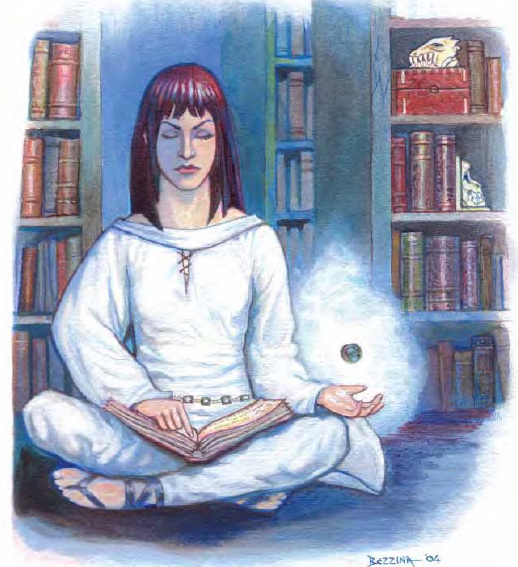
The Towers were regional affairs, and the Orders were divided by philosophy, but some universal body had to unite them all. The Conclave, a council of 21 divided by 7 mages of each Order, make decisions by majority vote on issues which can affect all member wizards across Ansalon. Their votes determine the selection of the Masters of the Towers, and the Master of each of the three Orders is drawn from someone serving on the Conclave. Unlike the Masters of the Tower, the Masters of the Orders can still sit on the Conclave and the three can cast tie-breaking votes and make decisions on behalf of their fellow Order Conclave members voting-wise when others cannot attend. And of those three Order Masters, one can become the Head of the Conclave who acts as a final arbiter and whose position is held for life barring gross incompetence, defying the result of a Conclave vote, or other reasons that demand the Head’s immediate removal. It’s not mentioned if there are term limits or how long a Conclave seat is held for non-Heads in this case.
Each Order has its own means of determining from among the Conclave seats who should be their Master. The White Robes are naive in the ways of politics and trust that their number will make the right decision when all options and points of view are presented in an open and honest manner. The Red Robes, much like their patron, aren’t exactly fond of bureaucratic red tape and determine their Master by drawing lots from among the seven Conclave members. The Black Robes hold secret competitions among their own which are usually dangerous wizard duels.
Not gonna lie, I kind of like how none of the Orders’ methods guard against magical or political corruption, and only the White Robes’ system has any means of selecting someone with a skill set based on good governing skills. Reminds me of the engineers and woo phenomenon.
Conclave meetings are commonly held at dates when at least one of three moons is in High Sanction, although emergency meetings can be convened in times of crisis. And meetings range on all manner of topics that can conceivably affect the Wizards of High Sorcery or arcane magic in general: assignment of funds to research projects, how to best combat threats to the Orders, and so on. The Conclave also has a Council of Three which are tasked with running the day-to-day activities of individual towers. Wouldn’t this be the job of a Master of a Tower?
Beyond this, we have a section on what happens to people who break the laws of High Sorcery and common punishments. Every wizard who passes their Test is instructed on the details of said laws, but mentors of apprentices are expected to integrate these rules into their lessons over time. The Conclave has created many regulations and is responsible for voting on the severity of punishment, but a few most pertinent to PC wizards are listed along with general levels of severity:
1. Using magic for common entertainment purposes is frowned upon because it gives the impression that magic is a silly, frivolous thing among the general public rather than something to fear and respect.
2. Using magic to to duplicate, create, or destroy fiat currency is banned, for it can exacerbate economic problems and gives governments a good excuse to punish, oppress, and regulate wizards.
3. Leaking confidential plans of the Orders to organizations outside High Sorcery is treated as treason/spying and punished just as harshly.
4. Wizards must abide by the rulings of the Conclave and senior Order members, even if they voted against a Conclave measure.
5. Activities of renegade mages must be reported to an appropriate authority figure within the Orders.
6. The Towers are neutral ground for all Order members. Acts of theft, violence, and similar acts on Tower grounds is punishable by varying degrees of severity.
7. Altering the foundational blocks of magic and creation is expressly forbidden unless permission is granted by the Conclave to do so.
Misdemeanors and first-time offenders with a good track record are given a warning. More serious offenses or repeat ones will be met with a higher-ranking member of the Order, who threatens that their organization will punish them if they do not stop or make amends. Said mage is then secretly monitored by Order members to the best of their ability. More serious incidents and/or rule-breaking caught by said surveillance have more serious punishments which tend to differ by Order:
White Robes either imprison offenders in a building designed to hold dangerous spellcasters or exiles them from the Order. In the latter case the wizard must either join the Red or Black robes or end up a renegade.
Red Robes do the same thing, but in some rare cases before exile ask the prisoner if they wish to consent to enchantment magic. This will alter their mental state so as to make them incapable of repeating the criminal activities. This violation of free will is so abhorrent to so many Red Robes that this is rarely used. But I’d like to mention that they’re the only Order which does this “mental behavioral therapy,” so this free will ideal kind of falls flat on its face.
Black Robes rarely police their own unless a Conclave vote forces their hand. In such a case they apprehend said member and subject them to torture as a deterrence method against causing the Order such an inconvenience.
Serious repeat offenders are apprehended and brought before the Conclave itself, while mages whose crimes involve some harm directed to a Conclave member or to magical development on a large scale never even get a trial: they end up mysteriously disappearing and are never heard from again.
Stat Blocks and Templates
Scattered throughout this chapter are stat blocks for notable mages throughout Ansalon’s history. We have Fistandantilus, who is an epic-level Black Robe wizard who specializes in necromancy magic; Magius is a 14th-level Red Robe wizard at the height of his power and heavily focuses on evocation and transmutation spells; Mistress Jenna of Palanthas is a 17th-level Red Robe wizard with levels in Spell Broker and has just about every item creation feat of note.
Finally we have the Master of the Tower template, which grants several powerful abilities as long as they remain within the Tower grounds: the ability to prepare spells from 3 cleric domains thematic to the Tower as arcane spells, automatically learning Time Reaver and the spell which grants safe passage through the Tower’s outer defenses, bonuses on Spellcraft checks and research time for putting new spells into their spellbook, and Spell Resistance of 10 + half their total levels in arcane magic classes (rounded down).
Thoughts So Far: I admit that I’m not entirely fond of this chapter. The explanation on Conclave politics is very in-depth but I cannot see it mattering in most epic high fantasy stories that Dragonlance encourages. I can see it as an offbeat adventure where the PCs have to grease the dysfunctional wheels of mage politics to unite the wizards against some greater threat, or get a sentence cleared for their wizard ally on trial. The Gods of Goods’ sanctioning of the Kingpriest’s purges was not something other sourcebooks talked about, so I do not know how canon is this part. But it really makes Paladine and company look bad, which even with the Cataclysm is saying something.
The Gods of Magic’s anti-sorcerer bias is understandable given the devastation of the First Dragon War, but treating all of them as walking time bombs who need to be exterminated or kept under heel is likely to exacerbate a potential war. Solinari and Nuitari finding common ground while their neutral sister shakes their heads shows how self-serving the gods can be.
On the one hand, I don’t think that having hypocritical deities and organizations falling short of their ideals is a bad thing in fictional worlds. There’s a bit of dramatic irony in the wizards oppressing sorcerers using the very same talking points the Kingpriests used against the Orders, which sadly has historical precedent in our own world. However, Dragonlance’s black and white cosmic morality (and by extension the rest of D&D) with clear lines drawn in the battle between good and evil runs up hard against this and leaves me shaking my head.
I felt that the history of magic veered too hard at times into unrelated material which sought to set up the backdrop of various Ages, but the core and setting books for the respective eras already cover these parts. I do like how the Conclave and the Orders have differing and sometimes arbitrary methods of resolution for various things; flaws in the system make for good role-play and believable conflict, and shows that just because people are smart in a nerdy area doesn’t necessarily mean they’ll be rational, reasonable, or skilled at governance.
Join us next time in Chapter Four as we get detailed write-ups on the five Towers of High Sorcery and other notable magical fortresses and academies of Ansalon!
the Towers
Original SA post
Chapter Four: the Towers
This chapter’s a bit of a peculiar one. It has detailed write-ups on the five major Towers of High Sorcery, and some minor write-ups of other notable locations of great import to wizards. Why this is peculiar is that three of the Towers have been long since destroyed, and their descriptions focus on the time periods when they still would’ve been at their peak before the Kingpriest’s purges. The two “surviving” towers, Wayreth and Palanthas, have write-ups for them during the current Age of Mortals although Palanthas is more of a dungeon now than a proper magic school. As such, DMs who are sticklers for lore will find this chapter of limited use barring time travel or games set during the Age of Might or Dreams (both which have the least material written for them in Dragonlance sourcebooks). The minor write-ups, however, have their details described for the current Age.
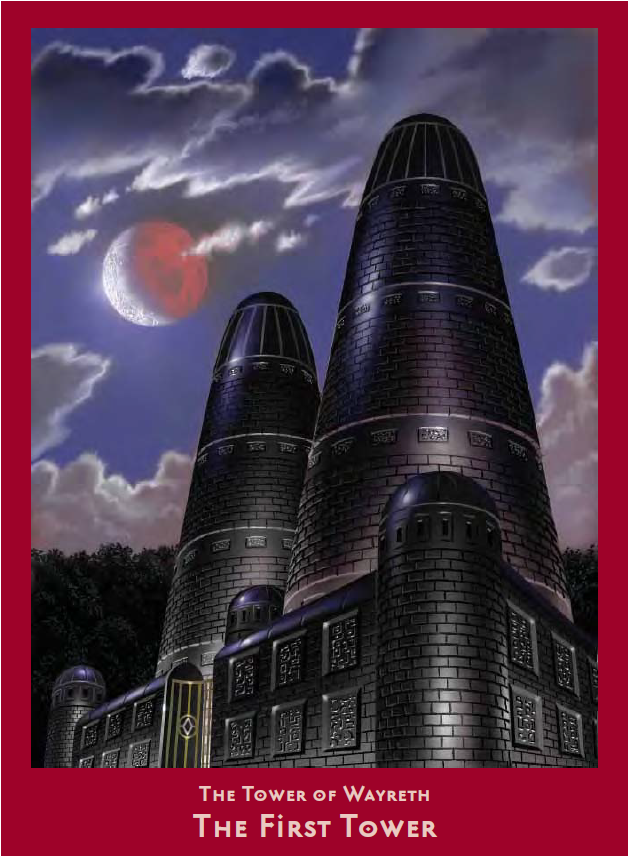
The oldest surviving Tower, Wayreth, is nestled deep within the forests of Qualinesti on autonomous territory, its teleporting properties and magical defenses making it impossible to locate unless its Master gives permission to those looking for it. The Tower has a near-religious level of respect among wizards of all Orders, and after the Kingpriest’s purges has been their closest thing to a safe community where they can live in peace. It is also where the Conclave holds assembly and where all prospective Order initiates must take the Test.
History: Its history is almost as old as that of wizardry itself. It was built first as a fortress-village by the three founders of High Sorcery, although its location proved a poor choice when neighboring goblinoid and human tribes attacked it repeatedly, which caused the wizards to devise Wayreth’s defenses. Their latest plan worked when the next barbarian army fell as their very weapons turned into snakes which attacked them.
Secure in their power, Wayreth served as a “wizard capital” for High Sorcery’s expansion, and maintained a primacy even as the other Towers were built after the influx of prospective mages began to test Wayreth’s limits. During the Age of Might and the Kingpriest’s purges, Wayreth managed to survive due to its remote proximity from Istar as well as the fact that the Kingpriest chose to spare it for unknown reasons.*
*In the Kingpriest Ascendant alternate timeline in Legends of the Twins sourcebook, one possibility was that the Kingpriests’ advisors told him that the destruction of all five Towers would unleash a magical cataclysm upon Krynn the likes of which have never been seen before.
During the Age of Despair, the death rate of mages was so high due to continent-wide violence and instability that they numbered 1/10th of their population in pre-Cataclysm times at the dawn of the 5th Age. It was the lowest point for Wayreth until the War of Souls, and the Tower became less of a school and more of a refuge and safe haven which housed almost all arcane spellcasters on the continent. Resources for developing new schools/towers/spells/etc were instead dedicated to preserving what they had left. Things were so bad that the Orders sent out a few trusted teachers to start schooling people regardless of their funds or education level in magic in remote and rural regions unconnected to major nations. The intent was to provide for a survival plan for High Sorcery in case even Wayreth fell. Ironically the Fourth Age was when the greatest number of poor, rural people became wizards due to this program. A White Robe became Head of the Conclave and helped teach Raistlin so that he may eventually fight the Dragonarmies. In fact, it was Raistlin’s role in the War of the Lance that improved public view of wizards after the war ended.
During the Fifth Age, the Orders’ numbers dropped to barely a handful when Takhisis stole the world for herself. Palin Majere and a mysterious figure known as the Shadow Sorcerer offered to teach the now-powerless wizards primal sorcery, which was a huge political issue among the wizards. Still, Wayreth’s latent magic remained, and Wayreth’s walls still stand strong. But even though the rest of the gods returned eventually, the Orders have never been less numerous or weaker.
Description: Wayreth is actually a cluster of gleaming black glass towers with walls impervious to all forms of damage. Three towers along the walls are temples to the moon gods who reflect their patrons’ moonlight when they’re full in the night sky. Most wizards travel here by magic so its front gates do not see much use. The towers have all the requirements for both a school and a community: apartments for living space, libraries, laboratories, gardens for crops and herbal supplies, and dungeons for holding dangerous monsters and people. The Conclave has its own tower, the Hall of Mages, which functions as part Wizard Congress/part courthouse, as well as the Testing Levels whose foundations appear different to every initiate who enters them.
The surrounding Forest of Wayreth is such that it casts a magical veil over a wide area, making it impossible for people to find it unless the Master of the Tower casts the Touch of Guiding Light spell upon the recipient. The forest looks spooky and weird, full of dead trees and a noxious freezing mist, but appears beautiful and alive for those whose presence is permitted. We have some descriptions of places like the libraries, the Testing Grounds, and the Hall of Mages but there’s nothing really noteworthy or special unless you like reading about what persistent 20th Caster Level spells are permeating the area.
The current Master of the Tower of Wayreth is a mysterious figure who has taken many forms, and nobody knows his or her true identity. But we do have a stat block, and the person is a bonafide 20th-level Eldritch Emissary, a new monster in Chapter 6. It’s rather funny, most of the high-ranking figures of High Sorcery in 3rd Edition Dragonlance sourcebooks are stupidly, campaign-endingly powerful. They can take all of the Dragon Highlords* out to lunch, and the few statted characters I’ve seen who may be able to challenge them are Emperor Ariakas (the final boss of the original Dragonlance campaign), god-tier Raistlin from Legends of the Twins (28th level), and the alien Dragon Overlords from the Age of Mortals (who are even more stupidly powerful with 30+ CRs and their own Colossal+ size category).
*the five military leaders of the Dragonarmies from the original Dragonlance campaign
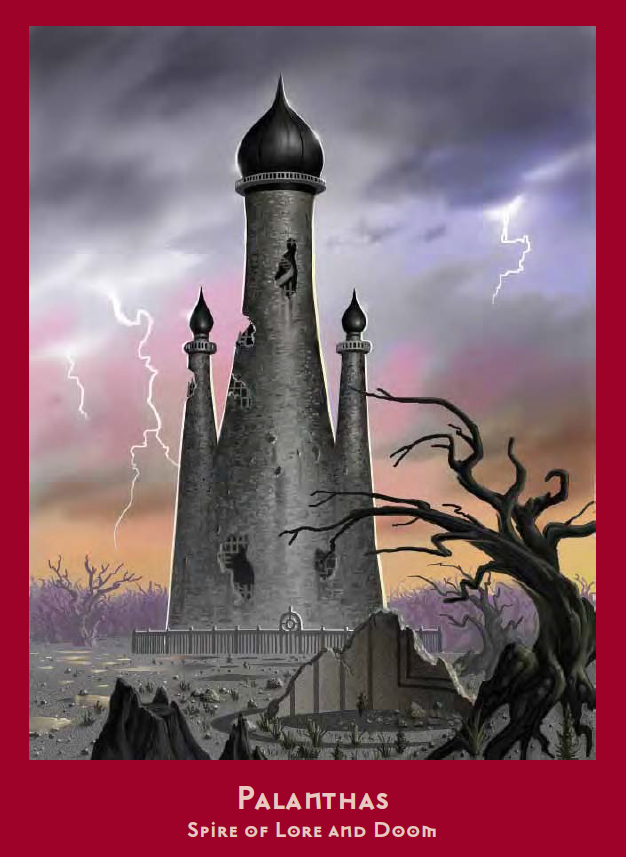
Palanthas is, rather it was, the only Tower that could give Wayreth some serious competition in arcane power. Its libraries dwarfed even that first Tower’s grandness, and it was the place where some of the most powerful artifacts were created and stored. But the Kingpriest’s purges forced the Tower’s defenders into placing a curse of desperation on the area.
History: The Tower was built in what was originally an Ergothian fishing village in Ansalon’s far north. When the other Towers were planned on being built, three of them were intended to be strongholds for the respective orders: Daltigoth the Reds, Istar the Whites, and Losarcum the Blacks. What would become known as the Tower of Palanthas was dubbed Tsandol Sirran, the Lore-Spire, to be the wizard’s greatest storehouse of knowledge.
Just like Wayreth’s foundations the non-magical neighbors were not happy to have wizards living in their vicinity, and some local merchants performed a Red Wedding with poison to kill the Tower’s chief builder. But he didn’t die, and through sheer willpower pulled himself from his deathbed and channeled Lunitari’s power inside him to raise the entire Tower by magic in one night before finally dying. The rest of the wizards hunted down and killed those who slain their brethren in vengeance, and planted oak trees around the tower to generate an aura of magical fear to intruders.
Over time the surrounding environs would grow into the great City of Palanthas. The local wizards proved instrumental in fighting Takhisis’ forces during the Third Dragon War, notably using the Dragon Orbs and the construction of the High Clerist’s Tower to trap and kill the invading dragons. The nation of Solamnia respected the wizards for this, and all was well until the Kingpriest’s purges caused even Solamnia to acquiesce to letting their forces through their territory. The wizards did not go down without a fight, and in desperation the Master of the Tower enacted a curse and committed suicide by leaping from its highest window. A foul magic spread around the Tower and the land, raw evil exuding the ground and air.
During the Age of Despair Raistlin would find a means of claiming the Tower for himself, using it as a base of operations for researching a way to kill Takhisis and claim godhood for himself. It was the only place on Krynn the mage could pursue his studies in secret away from the prying eyes of the Conclave. After the events of Dragons of Summer Flame and Raistlin sacrificing himself to save the world from Takhisis once again, his apprentice Dalamar became Master of the Tower as well as the Master of the Black Robes. He found a way to lift the curse and made it a haven for his Order.
During the Age of Mortals Dalamar teleported the Tower accidentally to Nightlund, Lord Soth’s domain, and ended up getting kicked out. Womp womp.
Description: This is the tallest of the Towers at 600 feet, and even in Nightlund the place is still a cursed bastion of evil. The foundations and the surrounding forest have a warped, decrepit appearance. Innumerable archives, museums, and libraries still contain much knowledge as well as strange magical items unrecognizable by modern eyes. Its only inhabitants are aberrant beings known as the Live Ones who are the cast-off remnants of Raistlin’s attempts at magically creating life, and the Tower’s Great Laboratory holds one of the five Portals to the Abyss.
During the Age of Mortals the relocation to Nightlund placed it within the Forest of Cypress, which is home to wandering souls whose mere touch drains the Strength from those unable to evade their pursuit. The Shoikan Grove’s aura of fear is still in effect, and there are countless undead patrolling the woods. The curse which presides over the Tower is back and in full effect, and there is no current known means of lifting it. The Master of the Tower during the Kingpriest’s purges currently exists as a spectre and guardian of the gates. He is a more reasonable 12th-level Black Robe wizard than the uber-powerful Masters of today.
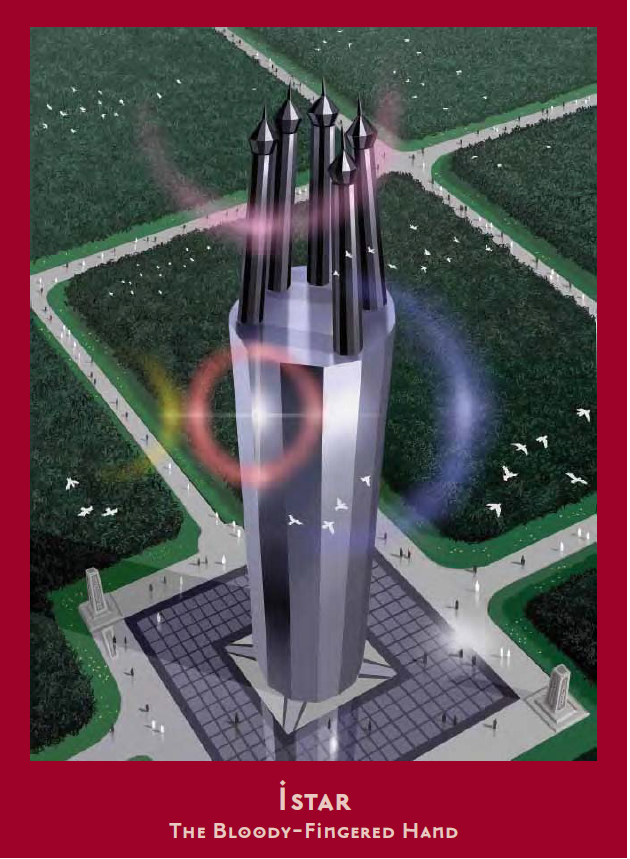
Istar housed the greatest collection of White Robes upon Krynn, their home away from home when their leaders weren’t meeting at the Conclave in Wayreth. During the Empire’s early years they had a great relationship with the Kingpriests, acting as government advisors. But in later years the final Kingpriests began to fear and resent their power.
History: With Daltigoth in the west, Palanthas in the north, and Wayreth in the south, a Tower was needed to occupy Ansalon’s east. There were many great cities with which the wizards could use as a nearby hub, but instead the White Robes chose a poor fishing village named Istar. Although their peers were angry at the choice, a seer named Asanta saw visions that this meager village would grow into the mightiest bastion of good in the world. And in later years she’d be proven right...for a time. The White Robes helped the city-state of Istar grow into a proper nation and then an empire, helping them conquer their rivals and erect their mighty spires. Amusingly the Legends of the Twins sourcebook illuminated that Istar’s earliest years were less about being holy and Lawful Good and more about waging economic warfare to become a thriving merchant hub. Which doesn’t seem very White-Robey in my view.
The people’s positive attitudes for the wizards waned when they devoted time and resources in fighting Takhisis’ forces elsewhere on Krynn. The nomads of Dravinaar, Black Robe allies and long-time rivals of Istar, waited for the wizards’ numbers to move before they struck, and the clerics of good-aligned churches filled in to protect them with holy powers. When a later civil war engulfed Istar, the White Robes backed the wrong contender to the throne and managed to avoid charges of treason through their own groves’ defenses and an uneasy truce.
When the final Kingpriest Beldinas took the throne, things worsened when the Wizards appointed a Red Robe and not a White as an advisor. And a decree to ban the Black Robes from all of the Towers (even the ones in Palanthas and Daltigoth, outside the Empire’s boundaries) was ignored. The Kingpriest did not like this, and after a failed assassination attempt by a Black Robe he settled on enacting a KILL ALL THE WIZARDS law.
The White Robes realized that the Kingpriest’s forces would claim the tower when their grove defenses were sabotaged, so they chose to evacuate the place and took as many artifacts and resources as they could via teleportation. The Kingpriest converted its use as a storehouse for blasphemous relics, both as a sort of museum to intimidate his religious enemies and a safehouse for magic items and propaganda deemed too dangerous to slip into the public’s hands.
Description: The Tower of Istar is a thing of beauty, its crystalline windows casting sunlight into rainbows and its five crimson turrets looking like they hold the moon of Solinari in its grasp at night. The wizards’ apartments all had balconies from which they could look out over the city, and windows were enchanted in the pre-antimage days to make it seem like the tower was made of stars. When the Tower was surrendered to the Kingpriest it became a darker, more drab affair, a shrine to heresy and supposed heresy of even good-aligned faiths. Many modern clerics theorize that this was the reason the gods took offense and sent the Cataclysm down upon Krynn.
The Balakan Grove is beautiful, unlike the last two towers’ creepy woods. Its primary defense was altering intruders’ memories to the point that they forgot the reason why they were there and emerge outside with no desire to visit again. Before its occupation, the Tower had a Chamber of Eyes which enhanced the power of scrying magic cast within its vicinity.
We also have a stat block of the last Conclave leader before the Cataclysm: Vincil Da Jevra, a 21st-level Red Robe Wizard. Yes you’re reading that right: 21st, although he has no ability or feat required to cast Epic level spells.
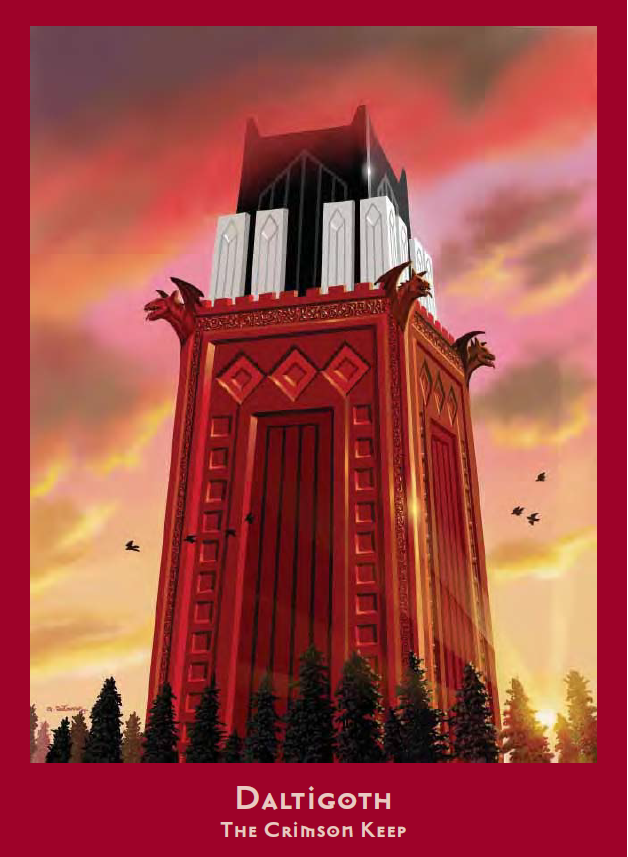
Daltigoth’s history overall fared better than its counterparts in Palanthas and Istar. The Empire of Ergoth was more tolerant of arcane magic, and the Red Robes helped defend the Empire from foreign threats but otherwise did not have much desire to meddle in politics. Sadly Ergoth would join the other countries in anti-mage sentiment over time.
History: Initially the Master of the Red Robes sought to build a Tower in Tarsis, the most beautiful city in Ansalon at the time. The local merchant princes agreed to let the wizards build there, but their greed sought to bleed the Order dry in new taxes and fees made up on the spot. In a fit of anger the Master destroyed his design plans and resigned as head of the Red Robes. An Ergothian mage by the name of Greytooth decided to build the tower in his homeland near a tense border region. As to why, the Empire could use the wizards as a safe buffer, and as part of gaining funds for Tower construction the Red Robes and more than a few Whites would serve in Ergoth’s armies. Their arcane talents proved invaluable in more than a few battles. The only low point was when the Emperor took offense at a Tower colored red rather than white, figuring the latter would better reflect his civilizations’ nobility. So the wizards played a prank by pretending to build a white Tower using illusion magic but upon its grand opening dispelled the illusions which revealed its red color:
quote:
This could have caused a great deal of trouble, but Greytooth knew Pakin for a pragmatic ruler, and also one possessed of a sense of humor. When summoned to the imperial palace to explain what had happened, Greytooth shrugged. “The stones beneath your city have spoken their will, Majesty,” he declared. “They did not wish to dim your bright and shining realm with their own glory.”
Pakin laughed at this, as Greytooth knew he would. Besides, there was no way for Pakin to change the Tower, now that it had taken form, other than tearing it down, which would mean no more magical aid for his armies. Still laughing, he proclaimed that the Tower of Daltigoth would stand as it was: “For as long as this great empire stands astride Krynn.”
The wizards of the west enjoyed a relative golden age in comparison to their peers, but this would not last. When a rebel movement lead by who would become the founder of Solamnia threatened to split the Empire, the Red Robes’ loyalties were torn as Vinas Solamnus countedmages among his allies. The Red Robes chose to remain neutral, Solamnia split off from Ergoth, and the Order barely averted an internal catastrophe by helping rebuild damages from the rebellion. When Ergoth began to be eclipsed by the rise of Solamnia and Istar, it seemed that the crimson-robed mages’ time in the sun was coming to an end.
During the Age of Might Ergoth saw a repeating series of foolish and selfish rulers which caused the relationship with the wizards to falter. There was a point when even the Conclave debated relocating the Tower. The Ergothian-wizard alliance broke when two of the Emperor’s sons died in a botched assassination attempt of the Kingpriest by a Black Robe wizard. Once the purges began the Ergothian Empire was all too willing to aid Istar in a joint assault on the Tower of Daltigoth which was also their capital city. When the Red Robes realized that they could not win the battle they decided to take their enemies down with them by magically exploding the Tower. This spell destroyed over a quarter of the city and killed off much of Ergoth’s leadership. Even before the Cataclysm the tottering old empire of the west had well and truly died: first they split ties with the mages, and after the Cataclysm so did the North split from the South.
Description: Befitting its origin as a military fort, Daltigoth is more stout and practical in design than the soaring spires of the other Towers, and the foundations of its stones are more or less unknown as they are a most unnatural color of blood which requires no paint. Its Kadothan Grove was also encircled by an outer wall with an open passage allowing entry. Its natural defenses warped space so that intruders were caught in an ever-lengthening journey; during this time the surrounding pine needles and crickets emitted sleep-inducing sounds and scents which could put even elves to dreaming.
The Tower within has straight halls and passages allowing for ease of movement, and parapets for the Red Robes to rain down spells and arrow-fire on invaders. The very hallways enhance the potency of illusion spells cast within, which were used to great effect during the Istar-Ergothian invasion.
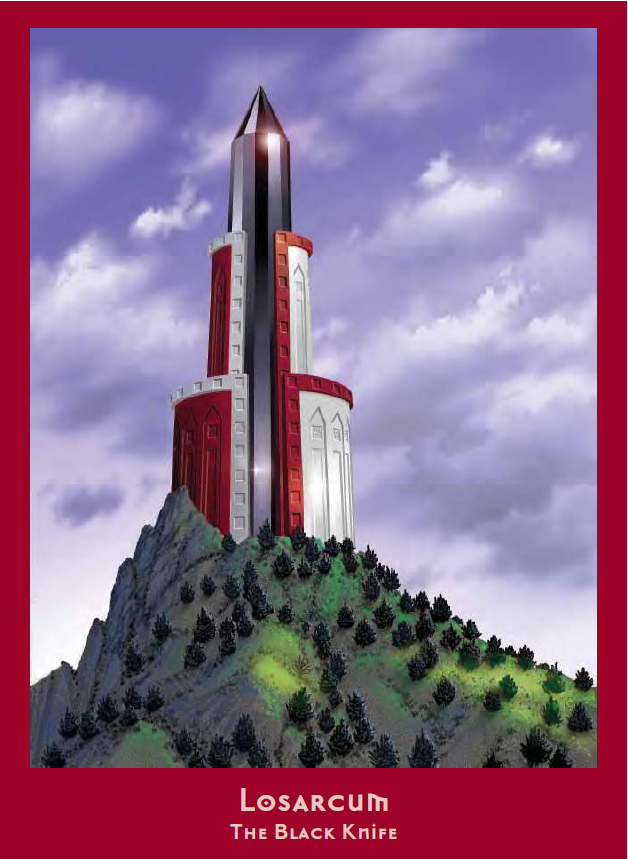
Our final tower was once called Qim Sudri, built in Ansalon’s southeast nation of Dravinaar. A no-man’s land of warlords and despots, only the Black Robes were ruthless enough to gain the fear and respect of the locales. When said nation was invaded by Istar, the tower was renamed the more proper Istaran name of Losarcum.
History: The high turnover rate and embrace of selfishness and evil made the Black Robes the least organized of the Orders, so it seemed strange that they’d dedicate a Tower all to themselves. The Master of the Order at the time only gained near-universal respect and fear by killing not one, but three of his rivals that challenged him. Finding a place to build their Tower wasn’t easy, as most cities and nations did not want them as neighbors. They claimed the Dravinaar city of Qim Sudri whose people grew up under generations of violence and blood feuds: it was theorized that a group of evil wizards would not have trouble blending in with such a place. And when said warlords tried and failed to attack the Tower-in-process, they learned to respect their new neighbors’ power. The Black Robes were all too eager to get involved in local politics and appoint tyrants friendly to their goals. There was even one point when the Master of the Tower challenged the city’s ruler to a duel of beasts, summoning a dragon to fight for him when the best the opposition had were dogs and hawks. Needless to say the dragon ate the human losers as well as the animal ones.
Dravinaar was shaping up to be a veritable eastern power in Ansalon with the Black Robes ruling openly or as advisors, although during the Third Dragon War their luck ran out when they thought to attack Istar when the White Robes were busy fighting Takhisis. Istar had a veritable force of clerics to protect their capital and repelled them with such force that their nation went into a period of rapid decline. Istar’s theocracy decided to conquer Dravinaar to enlighten them, and the long-suffering population found it a dramatic improvement over the former tyrants. The Black Robes’ Tower was the only standing monument to the bad old days, a black knife jutting out of the holy land. The Black Robes decided to avoid Istar’s ire by pretending to go along with a demand to leave, using magic to make it seem that their Tower was evacuated.
But even this charade wouldn’t last, and the Black Robes were causing trouble elsewhere in Ansalon, so they became the first targets during the Kingpriest’s purges. The discovery of the illusion and an assassination attempt by a Black Robe was all the pretext the Kingpriest needed to declare war on all of High Sorcery, and like Daltigoth the Tower’s own Master blew up the building than let it fall into the hands of the enemy.
Description: The Tower’s structure was made of black obsidian shaped like a dagger rising into the sky, earning it the name the “Black Knife” among the people of Dravinaar. Its position on the promontory east of the city made it cast a long shadow down upon Losarcum, and it never reflected the moonlight of Solinari or Lunitari but it did give an outline of Nuitari to those who looked through the tower windows. The apartments’ inhabitants were organized by their hierarchy in the Black Robes, with the greatest living at the peak, and nearly half of the towers’ rooms were in caverns beneath the first floor. The Tsorthan Grove’s defense was to magnify an intruders’ emotions to the point that they were driven insane.
Beyond the Towers
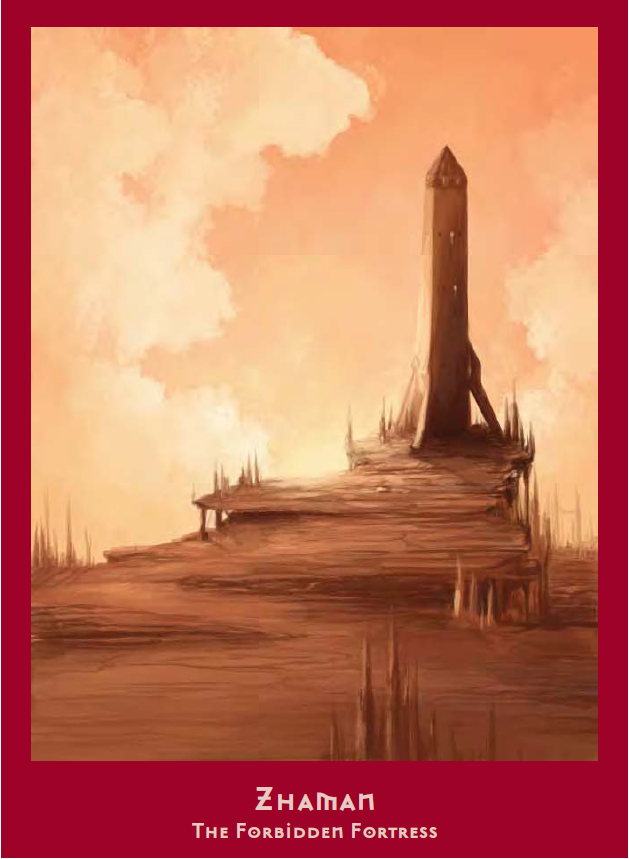
Now that we covered all five Towers, this last section of the chapter details four other notable locations important to High Sorcery.
Zhaman, the Forbidden Fortress: Zhaman was built by a Black Robe archmage and mercenary who specialized in killing kings and overthrowing governments so that his clients could enact regime change. He used his ill-gotten wealth to built his own private fortress near Thorbadin, and it got a foul reputation among the local dwarves. The place was a veritable death-trap, full of captured monsters and magical guardians along with an ever-changing crystalline maze to confound any invaders. Zhaman’s reign of terror came to an end when he accepted a contract to overthrow the Orders and planned an assault on the Tower of Wayreth. Suffice to say that he and his mercenary army died horribly, and the Orders repossessed his fortress to convert to their own use before sealing it when they could no longer maintain it.
The fortress was later reinhabited by the archmage Fistandantilus, who used it as a base during the Dwarfgate Wars. Its entrance was reshaped to look like a giant imposing stone skull.
Castle Uth Krevan, the Citadel of Gadar: The Solamnic border keep of Uth Krevan had its entire noble family slaughtered by a peasant revolution; abandoned by the people, the place became inhabited by hobgoblin raiders. A Red Robe Wizard by the name of Gadar had a falling out with the Conclave and decided to reclaim the castle for himself where he could practice magic in peace.
But of course, a mage who has the power to single-handedly kill off troublesome hobgoblins and repair a castle is almost doomed to end up involved in interesting times: his family fell under a wasting disease which no arcane magic could cure. Gadar began to experiment in necromancy in finding ways of saving them. The Castle became a terrible, ghost-haunted place as the mage kidnapped countless people for experiments. His reign of terror came to an end when two Heroes of the Lance, Tanis and Flint, invaded his castle and killed the mage. This was before the Dragonlance Chronicles proper, while they were on a five-year journey to find signs of the true gods before reuniting with friends at the Inn of the Last Home.
The Castle was once claimed by the Knights of Takhisis as a fortress, but it stands empty once again.
Ulgaard, the Dark One’s Hall: This is one of Fistandantilus’ hidden lairs, an underground maze of tunnels that could only be entered by teleportation. He used it as one of his many safehouses, a training area for his apprentices, a place to summon demonic minions, and a supernatural prison housing the undying bodies of his most hated enemies. It remained untouched until Raistlin and Dalamar learned of its secret location.
The School of Mysteries, Towerstone’s Hope: During the War of Souls the loss of the three moons reduced the Wizards of High Sorcery to but a few dozen desperate holdouts. A young White Robe by the name of Adriana Towerstone came into the Order shortly before Takhisis stole the world. Unwilling to admit defeat, she did all she could to study magic in hopes of finding a way to reverse this unfortunate event. Adriana studied for years, isolated in far-off libraries. When the gods reclaimed the world she was an old woman, but learned so much that she was now one of the most powerful White Robe wizards. The refounded Order of White Robes even desired her as Master, but instead Ariana wanted to build a school of her own which the Conclave more than happily gave her. She built three towers outside her old Solamnic family home, and her school is new but steadily growing. The low number allows for a more intimate, hands-on feel where she can better oversee her apprentices’ development. The School of Mysteries even built a Grove of its own, which instead of warding off intruders makes them kind-hearted and eager to learn magic.
Thoughts So Far: The Towers seem to cover a middle ground in terms of Dungeon Master aids. We have overviews on the five Towers and their histories, but not enough detail to run games in them barring a barebones structure. The fact that only one of them is friendly to visitors in the modern campaign setting, or even the War of the Lance, limits their gaming potential. Palanthas can make for a potentially fun dungeon crawl, and Istar is currently beneath the waves, but the outline for the latter Tower is pre-Cataclysm. The stat blocks for the various Tower Masters and former Conclave leader are so high-level that you’re not going to use them in most campaigns. Ironically the more minor locations at the end are the friendliest era-wise, but they have even less space dedicated to them.
Join us next time as we cover in the next chapter how to create Tests of High Sorcery for your own wizardly PCs!
the Test
Original SA post
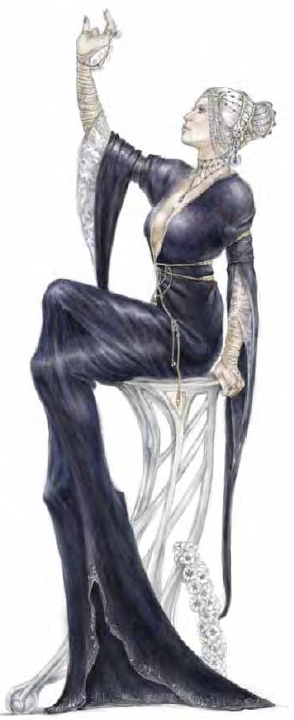
Chapter Five: the Test
Forgive the lack of relevant pictures, this chapter is short but otherwise all text…
...but what a chapter it is! Unlike the previous which are more overall backstory, this one is all about the Test and more importantly how the Dungeon Master can craft one for his own gaming group.
The Test was invented around the Age of Dreams to cut the wheat from the chaff; and when Wayreth was being built people were hearing all about this new ‘moon magic.’ In no time at all the Orders were dismayed at well...how many people showing up were quite clearly unsuited for being a wizard:
quote:
Some of those wanting to belong were serious students of magic and would be welcome members. Others obviously had no interest in the Art of magic at all. Among these were kender, who came in droves. Young nobles arrived with the expressed belief that learning magic would be “jolly fun.” Some announced they had developed schemes for using magic to turn a profit. Still others came with more sinister purposes, convinced that they could use magic in obtaining revenge against those who had wronged them.
The kender conspiracy theorists were right!
A screening process was necessary, and so the Test was born: not only to measure a prospective mage’s competency, but also to ensure that they were “motivated by dedication to the magic and not purely selfish or sinister reasons.”
So umm, what are the Black Robes then?
But most importantly, the declaration that any who took the Test and failed would be executed caused many people to rethink whether or not they wanted to take up the path of High Sorcery. This in theory would ensure that only the best people would succeed. In practice this initially caused a dramatic upsurge in renegades when the Test’s requirement were applied to all current Order members including the Conclave and other high-ranking people. But the Gods of Magic lent their support behind the universality of the Test, and attempts at renegades breaking off and forming their own factions turned to failure.
The Conclave monitors known minor wizards throughout Ansalon and gives out magical messengers bearing invitations to wizards when they reach 3rd or 4th level in an arcane casting class. The message is a cordial invitation to a Tower (Wayreth post-Cataclysm) explaining the details of the Test as well as the boons for formally joining an order. 3rd-level and above spells are regarded as too dangerous to keep in the hands of renegades, so characters who ignore the Test and keep gaining arcane casting levels (those who choose to remain dabblers are safely ignored) risk being branded a renegade and hunted down.
Should the prospective mage choose to accept, they must travel to a Tower of their own volition and skill, which is a pseudo-test of its own to measure their dedication.
quote:
The three Orders come together to create a Test for a new candidate. Using many magical tools at their disposal, the wizards giving the Test learn intimate details about the wizard to be tested. Looking into the past, the archmages view some of the incidents that shaped the candidate during childhood. They peer into dreams, and learn the secrets that the potential mage will not admit to anyone. Though some might view this as an invasion of privacy, such scrutiny is an important step in crafting a Test that is personal, challenging, and unforgettable. Wizards who agree to take the Test are given to know that such an investigation into their private lives is going to be undertaken and may choose not to proceed with the Test.
Ermm, I wouldn’t want most people, much less a Black Robe guy, knowing my innermost fears and secrets. This whole thing sounds like it has potential for blackmail material. Granted I could see the Orders doing this as a safety precaution against turncoats and traitors, but the book doesn’t really acknowledge these weaknesses. Beyond this the wizard has every opportunity to back out of a Test before it begins, even up to the very last moment. But once it begins they must either succeed or die trying.
Crafting a Test of High Sorcery
Enough about the backgrounds for the Tests, how do we build one to run for wizard PCs? First off we get the basic structure: every Test takes place in a Mindscape spell, with real rooms connected within the Tower and the surrounding land known as the Testing Grounds to further enhance the illusion. Each challenge or trial takes place within a “room” which can be as small as a closet or as large as an entire building or city within the Mindscape. The connections between the rooms are typically literal doors which vanish once they’re passed and can defy the mage’s perception of time and space: one room may be a deserted island at night, and a door standing on its own on the beach may lead into a room which is an undersea palace. Wizards cannot use magic to circumvent these rooms, and barring summoning spells they cannot make contact with people not part of the Test without failing due to cheating.
The Test has at least 3 challenges that examine a mage’s knowledge and use of magic, tailored to the strengths (and weaknesses) of said mage to ensure a reasonable level of challenge. There must also be at least three tasks during the Tests that cannot be solved through their current spells alone, and one challenge must involve a confrontation of some sort with a known ally. And all Tests involve pitting the mage in solo combat against a dangerous opponent. In addition to skill, several rooms of a Test need to have some sort of moral challenge which can give an insight into the mage’s outlook on life and thus determine which Order they will join upon completion.
Wizard PCs who act differently than their alignment during the Test have said alignment changed to match their Order, which is...something, although that does bring up the question of mages who decide to act differently knowing that the Test is ‘not real’ unless the Mindscape is meant to illuminate how you really are on the inside.
The Encounter Levels, or total measurement of a challenge juxtaposed against the Average Party Level, differs depending on whether the mage is taking the Test on their own or chooses to bring along allies to help them: solo mages face challenges typically 2 below their level, while standard party sizes of 3-4 people follow the typical 3rd Edition Encounter Building rules. 1/3rd of the Test’s Challenges are 1 higher than the average, while the solo duels place the mage against an enemy 1 Challenge Rating higher than their level; in rare cases where the Test-takers permit allies to help, they can be 2-4 CR higher than the Average Party Level.
Finally, the Test-taker(s) has the option before every room to alter the Risk Level: each room gives out 2 Risks Points upon completion by default, but can be altered to as low as 1 or as high as 4. Each Risk Point below or above 2 alters the relevant d20 rolls of the challenges and opponents by 1: enemies get bonuses or penalties on attacks, saves, skill checks, etc, while the DC for obstacles the PC(s) rolls against shifts by the reverse factor.
I’d like to mention that unlike other Editions, +1 and +2 modifiers individually are nothing special. A big portion of the D20 system is combining individual modifiers together to get powerful buffs, and the swinginess of a twenty-sided die along with some spells which can really shift things around. For example, Jump gives +30 on Jump checks and is a 1st level spell, while Displacement causes attacks against you to miss 50% of the time regardless of modifiers. This means that going whole-hog at 4 Risk Points may be more a moderate inconvenience rather than a dire upsurge in challenge for players who know what they’re doing.
At the conclusion of a Test, the Risk Points are added up and divided by the total number of areas* to create an average. All mages receive a permanent magical item as a reward ranging from 750 to 16,000 gold/steel pieces ideally themed around their casting style. An average of 2 Risk Points also gives a mage the opportunity to permanently increase their Intelligence score by 1 on a DC 20 Intelligence check. 3 Risk Points also gives the wizard a free bonus feat which must be replated to magic (item creation, metamagic, Spell Focus, etc). And for those brave souls who averaged 4 Risk Points, they have their soul changed in a process known as the Soulforge which bestows upon them an irreversible physical change. This is what gave Raistlin his hourglass eyes which cause him to see all things decay.
*it doesn’t say if by total they mean all conceivable rooms (22) or the number of rooms the mage passed through to complete the Test. I presume the latter given that depending on their route the mage can go through as few as 3 rooms or as many as 9.
So what does a Soulforge give, mechanics-wise, given it is the hardest reward to achieve?
Nothing. Barring DM Fiat it is entirely cosmetic or a minor handicap, related to the Test in some way or a perceived personality flaw of the wizard’s: eyes that change colors to match their mood for a wizard who loses control of their emotions too easily, a forked tongue for a wizard who is a pathological liar, a magical tattoo which changes based on the surrounding environment for an absent-minded wizard, etc.
That’s a real kick in the pants. You’d only ever put Risk Points that high from a mechanics perspective to get the most potentially expensive magic item reward you can.
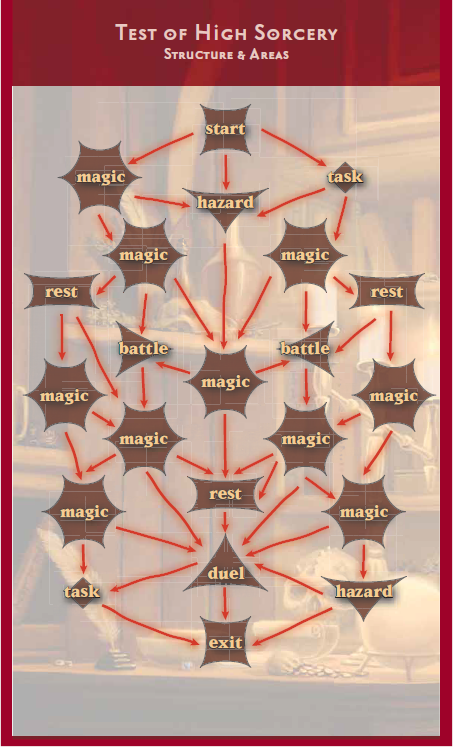
Rest Areas are places of comfort and safety, intentionally created so that a mage may sleep, tend to their wounds, and refresh their spell selection. They usually take the forms of bedrooms, inns, scenic areas of nature, and friendly villages with helpful inhabitants.
Battle Areas are straightforward opponents who wish to do the mage harm, or potential harm depending on the mage’s actions. Unlike the duel areas they are not one-on-one and can include multiple (usually weaker) opponents. They rarely take place on a “Final Destination” featureless plane and oftentimes have bystanders, potential allies, and environments which can be helpful or harmful.
Hazard Areas are places which can be harmful to a mage but are not an enemy to overcome with violence; such enemies that may exist are tangential to the main challenge. The room’s obstacles can range from typical dungeon traps to deadly weather and earthquakes.
Task Areas are not usually lethal but present a puzzle or conundrum which requires wit and skill to overcome. The samples given include an easily-offended spirit running a crooked shell game which must be won to pass, a medusa asking the PC to fetch her a cup of water from a well with no rope or bucket, and the like.
There is only one Duel Area in an entire Test, and its opponent is always another spellcaster whose skills are tailored to exploit the PCs’ weaknesses. Samples given are a wizard with a sense type the PC doesn’t have (such as darkvision) who exploits the environment to blind them, a clone of opposite alignment, and a rogue/wizard who knows all of the hidden traps in an area and will bait the PC into triggering them.
Magic Areas are a bit of a catch-all category in that they are specifically designed to be solved by the mage’s spell selection. Rest areas often give clues on what spells may be ideal for future Magic Areas based on this. Examples provided include the proper use of divination spells in a maze to pick the safe rooms rather than the monster or trap-filled ones, using illusion spells to throw off enemies hunting the mage, or being trapped in a burning building where water or movement/teleportation-based spells can help the mage escape.
Failure Means Death
In spite of all the talk about the weighty responsibility of taking the Test, the writers felt that killing off a PC for failure may be too mean and come up with ways for a PC to succeed in spite of failure. Rather than being a penalty for a bad die roll and poor luck, those in charge of the Test may feel that a wizard has proven their worth and let them pass but give them a physical mark or debilitation as a reminder.
quote:
Death should be the punishment for:
1. A wizard who fails repeatedly during the Test due to lack of study: he casts the wrong spell, uses the wrong spell components, can’t recall the spell, can’t read his own scroll, etc.
2. a wizard who is careless and/or foolhardy: he gets drunk at the rest area instead of studying his spells; he refuses to take the Test seriously, but clowns around, behaves stupidly.
3. A wizard who indicates in some way during the Test that he is or may become a threat to the Orders or to fellow wizards: a Thorn Knight who lies about his true allegiance in order to sneak into the Tower to assassinate the Master, a wizard-thief who plans to use the Test to try to steal a valuable artifact.
I cannot help but feel that this takes out a lot of the dramatic tension in a Test. PCs are competent in their field of choice by default and #1 and #2 won’t really happen unless the player role-plays their character as such. #3 would be the kind of thing that would be detected during a pre-Test screening as I’m sure it’d count as a “deepest secret.” But I can see the Thorn Knights and skilled mages finding ways around this, although in the latter case they’d likely be a lot higher than 4th level.
Thoughts So Far: Although it has some warts, this a pretty good outline for Dungeon Masters to build Tests. For games which start at higher level (like the 3rd Edition Dragonlance Chronicles update) I can see some wizard PCs preemptively stating that they took their Test at 4 Risk Points to get the most boons, but a free feat, magic item, and potential +1 Intelligence aren’t exactly what I’d call gamebreaking. I will admit that I had a lot of fun with this chapter in high school, and used it to create my own Tests for my Dragonlance campaigns. If I were to do it now I’d suggest altering the DCs for larger factors for well-built PCs and dispense with the Encounter Level in favor of eyeballing enemy stats. This is because Wizards of the Coast’s own designers admitted that the 3e Challenge Rating system was broke and they just winged it in their own games.
Join us next time as we look at new monsters and magical minions in Chapter Six: Creatures!
Creatures
Original SA post
Chapter Six: Creatures
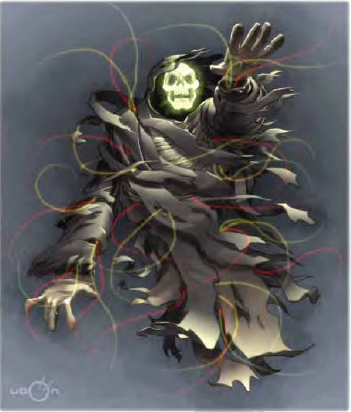
We’re in the home stretch, baby! This post is a 2-for-1 special due to the fact that the final chapter is really short. The meat of this section covers the new monsters, creatures which are either artificial creations of wizards or have some ability which makes them vital or dangerous to the work of High Sorcery.
Some things to clear up first. Quite a few of these monsters are related to the Ethereal Plane, which works slightly different in Dragonlance. For one, it is also the realm of dreams where spectral realms are conjured up by unconscious mortal minds. The Ethereal Plane as it’s commonly known in D&D parlance is the shores of the Material Plane, part of a much larger Ethereal Sea (aka the Deep Ethereal) which stretches to worlds beyond and is full of strange monsters never before seen on Krynn. When Takhisis stole the world during the Chaos War, her relocation of Krynn picked up quite a few strange monsters along the way.
We don’t have any new Familiars, but the book explains how the mundane animals are by far the most common. While some extraplanar familiars are not unknown, they are not exactly a welcome presence in magical academies. Pseudodragons are rare to the point of extinction in the Fifth Age, and during the Fourth Age they’d be in hiding pre-War of the Lance.
Dread Beasts are undead animals meant to serve as spies for necromancers. Unlike typical zombies they are intelligent and have a telepathic link with their creator which can work out to 50 miles, and they emit disease and foul smells which can debilitate opponents in battle. We also have a Create Dread Beast spell and rules for having them as cohorts, although the monster and spell are evil-aligned so it’s not exactly suitable for heroic parties.
In Dragonlance the Ethereal Plane is closely linked to the dreams of mortals, although the unconscious musings of powerful entities and lucid dreamers can form more ‘real’ substances. Spells such as Mindscape can further solidify these phantasmal realities. Dreamshadows are quite simply illusory entities representing existing creatures: they are a simple template which has all the base qualities of the character/creature in question, save that their attacks count as illusions for rules purposes and they deal 1 Wisdom damage on all of their attacks. Dreamwraiths on the other hand are a specific species of malevolent entity spawned from nightmares and wicked thoughts. They function more as “hit and run” enemies who have high Wisdom and Charisma based skills, and in addition to the Dreamshadow traits they have a gaze attack which causes depression.
Eldritch Avatars are manifestations of raw magic, either from a powerful magical item or a nexus of arcane power. They can take just about any form, from monsters to humanoids, but their unifying factor is that they cannot ever make use of or learn divine magic. Eldritch Emissary is a template for magical locations whose main abilities include being able to cast spells from 1-3 cleric domains as arcane spells, the ability to reform upon death, and can temporarily discorporate from anti-magic spells. Eldritch Haunts are keyed to specific magic items. They are capable of shapechanging into said item (they are one and the same) and back to its creature form, can use the abilities of said item as though wielding it (such as gaining armor bonus if armor, cast spells from a wand’s charge as spell-like abilities, etc), and have the power to drain other magic items of charges to replenish its own charges.
Fogdrakes are an ancient species of dragon which are nearly extinct. They are wicked souls who glide instead of fly and can detect when an arcane spell or magical item has been “cast” within 300 feet. They can also charge on a full attack, rage as a barbarian, and are constantly surrounded by a curtain of mist which they can see through thanks to Blindsight.
Huldrefolk are basically “grey aliens” in Dragonlance. They existed since the Age of Starbirth, making them older than all life forms on Krynn, and began to depart to the Ethereal Sea through standing stone portals once the gods put the souls of stars into mortal bodies. Huldrefolk are believed to be the ancestors of all fey, and while some visit Krynn they are so rare as to be mythical. They can cast spells as 8th-level sorcerers and gain a variety of powers related to a natural domain (Animal, Plant, or one of the four elements): they learn said domain spells as sorcerer spells, can merge their bodies into things made of said domain, teleport between them akin to the Tree Stride spell, and speak with the objects of said domain even if they’re not normally capable of speech.
Remnants are incorporeal undead which look like glowing cloaked skeletons. They are what happens when a powerful arcane caster dies from a surge of raw magical energy, which in turn spontaneously animates them. Remnants are mostly (but not always) chaotic evil beings resentful of the power they lost. Much like the shadow undead they can create more of themselves via an ability drain touch (Intelligence) and are powerless when exposed to natural daylight.
The Thaumavore is our final monster, extraplanar incorporeal eel-like things from the Ethereal Sea. They are completely alien to Krynn and said plane’s very environment harms them, so they only ever appear in the mortal world due to a botched summoning spell, unstable planar rifts such as Takhisis stealing the world during the Chaos War, and so on and so forth. They are instinctual beings, capable of detecting, seeking out, and draining magical energy for sustenance as a touch attack. The more spell levels worth of energy they drain the more innate magical spell-like abilities they can cast. Said spell-like abilities include a healthy mixture of defense (blink, protection from good/evil, anti-magic field, etc), mobility (dimension door, plane shift), and debuffs (ray of enfeeblement, touch of idiocy, confusion, etc). The Plane Shift spell is the most costly in terms of charges, so needless to say it will cast that as soon as possible to return to the Ethereal Plane.
Chapter Seven: Rivals
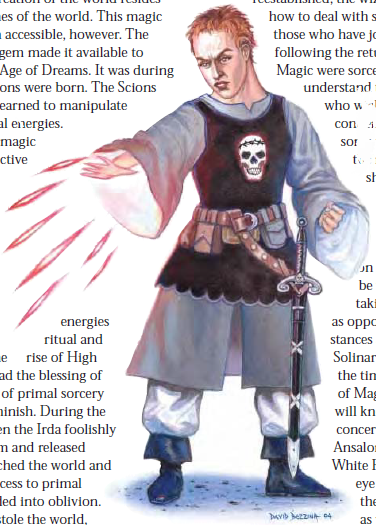
Numbering a mere five pages, this is the shortest chapter in the book and covers the Wizards of High Sorcery’s relationships with other spellcasters and magical organizations of Ansalon. It’s rather general and broad-sweeping, for example covering divine spellcasters in general as opposed to specific priesthoods.
Renegades are perhaps the most well-known adversary to the Orders, although not the greatest currently (that’d be the Knights of the Thorn). They come from all walks of life but their unifying factor is their unwillingness to work within the strictures of the Conclave and Orders. Although those who refuse the Test are perhaps the most well-known, there are more than a few Robed wizards who end up exiled from their parent organization. As the Red and Black Robes are more hands-off in regards how individual members conduct themselves, said exiles tend to be very dangerous individuals pursuing some universal taboo or committed great crimes against the Orders as a whole. A few renegades are technically such, but live in such isolated or far-flung corners of Krynn that the Wizards of High Sorcery simply haven’t discovered them yet.
We have stats for one renegade, a wicked transmuter by the name of Rieve who has a bit of a folkloric reputation among story-tellers. He’s a 10th level (ex) Black Robe who specializes in evocation and transmutation magic, particularly polymorph and self-enhancement buffs.
Sorcerers doesn’t really detail much that hasn’t been covered in previous chapters, save for the fact that most of them describe spellcasting as “drawing power from within and within the world.” Most of them are technically renegades but can get away with it due to the fact that they aren’t limited by typical factors such as literacy which need to produce wizards. Compounding this is the fact that during the Fifth Age they were the major arcane spellcasters for half a century while the Orders remained powerless and thus have a head start on numbers and power in the Fifth Age.
Knights of the Thorn are the largest organized opposition to the Wizards of High Sorcery on Ansalon. All three Orders attempted to destroy them in their infancy during the siege of Storm’s Keep. Said battle ended in a draw, where the Orders were unable to complete their mission and had to retreat when Takhisis stole away the world. Although said goddess is now dead, the Knights of Neraka control a huge portion of central and eastern Ansalon. Unlike the Orders they are just as willing to recruit sorcerers into their ranks, meaning that in the current Age of Mortals they are pretty much the largest group of arcane spellcasters in Ansalon. The Orders have yet to resume their war, but it is only a matter of time.
Clerics have been treated hands-off by the Wizards of High Sorcery* due to the fact that unlike sorcery there’s no real means of said magic growing beyond the caster’s control due to the strong hold their patron deity has over the acquisition of divine magic. While Wizards of High Sorcery can only have their respective moons as their patron deity, they can respect the ethos of various gods: Gilean’s emphasis on knowledge makes his priesthood a popular choice to work with for wizards, while Sirrion’s connection to alchemy and creativity is also a boon. The White Robes have a close working relationship with the priesthoods of Paladine and Mishakal due to said deities’ roles in the War of the Lance and in restoring and recovering lore from ancient ruins. The Black Robes are an exception, for Takhisis’ attempts at making her own wizarding Order has made him paranoid of losing any more potential Black Robes. Combine this with the fact that most non-Takhisis evil gods are a rather reclusive lot (and Sargonnas’ strong link to the anti-arcane minotaurs) makes this feeling from the priesthoods mutual.
*Historically the opposite has been true, what with the Kingpriest and all.
Mystics are the other primal spellcaster which emerged during the Age of Mortals. Its power source stems from a universal energy present in all living things, and is the “divine” equivalent to sorcery even though it does not stem from any of the gods. Wizards are as distrusting of mystics as they are of sorcerers partly due to its similar seeming Chaos-spawned origins. However they are a bit more tolerant of the Citadel of Light as an institution which trains said mystics, although in a more “pick your battles” way in that the Knights of the Thorn are much larger, more powerful, and more present a threat.
Although it’s nestled in the back of the book, it is technically impossible to be a Mystic Theurge of any kind in Ansalon barring the Knights of Takhisis during the Chaos War. But with Takhisis dead, that avenue is now lost. As a moon counts as a “patron deity” wizards/clerics have to choose one or the other. The Mystic entry also explained that attempts for arcane spellcasters of both kinds in learning mysticism have failed as it appears that wild magic and focused magic simply cannot mix. You'd think that this is something that would be included in the core Dragonlance Campaign Setting considering how explicit the rules have been regarding class restrictions of other kinds: no post-Cataclysm non-evil divine magic before the War of the Lance, no spontaneous casting classes before the Chaos War, play a multi-class Knight of Solamnia instead of a Paladin, etc.
Thoughts So Far: The monsters are quite interesting and I can see them being used for some nifty encounters. An Eldritch Haunt magical item can make for an offbeat sort of treasure, while Dread Beasts are perfect for necromancer minions beyond the stock skeleton/zombie tropes. If there’s one weakness in the bestiary it would be that the chapter’s rather template-heavy and so there’s not as much pre-created stat blocks ready to go. Remnants are too similar to shadows, while the huldrefolk feel a bit too sci-fi for Dragonlance. I do like the thaumavore even though they’re unlikely to be a “long-term” opponent or the kind that will hang out in a room during a dungeon crawl.
I don’t have much to say on Rivals one way or the other than the fact it gives out some rather vital information too late in the book. The Thorn Knights’ prominence puts the anti-sorcerer bias into some perspective, although they’re never mentioned in prior chapters, whether pro-recruitment (“we need to get the sorcerers to trust and join our Orders because they’ll otherwise be ripe pickings for the Knights”) or anti-sorcerer (“most sorcerers are likely sympathetic to the Thorn Knights so we may as well persecute/kill them”).
Concluding Thoughts: Towers of High Sorcery is a mixed bag. It has a lot of good material to use in one’s gaming groups, Dragonlance or otherwise. But there’s a lot of material which is either mechanically suspect, like the “divine emulation” spells, or fluff text which is inconsistent with the world presented and ends up leaving more questions and plot holes than answers. There are times when it feels like chapters were written separate from each other rather than being part of a larger whole. Examples of this include key information being relegated to the very last pages, or how the Text is meant to weed out unethical minds despite the fact that the Black Robes are all about self-empowerment at the expense of others.
This is probably one of the few 3rd Edition sourcebooks where I can say that I liked the mechanical crunch more than the fluff; in the realm of third party products it’s usually the other way around. As to whether the book itself merits a purchase, I cannot say yes given that its chapters cover some very different ground and even by themselves do not often have enough material to use holistically beyond piecemeal insertions.
But that hasn’t quelled my passion for Dragonlance. For my next Let’s Read I’m going to cover the War of the Lance sourcebook, a setting companion which details the continent of Ansalon during the iconic original Dragonlance Adventures but for 3rd Edition!
